#Ananke: Killer
Explore tagged Tumblr posts
Text

𓆙 "My my, this 'Ethereal Skyway' business certainly sounds like an ambitious idea." Personally, Ananke found the notion not lacking in imagination itself.
#CHRONICLES OF THE TRAVELER (Ananke ic)#SEVEN TWO THREE TWO THREE... SEND (dash commentary)#Ares: -explain his crazy ideas-#Ananke: Killer
0 notes
Text
DR CHARACTERS AS HALF BLOODS!!!!
so the other day I was reading pjo, and when the book mentioned that Hermes was also the god of gamblers, my mind immediately went to Celestia Ludenberg, a danganronpa character who’s the ultimate GAMBLER. That got me thinking about other possibilities, and the result is this huge list of dr characters as half bloods!
THH
makoto - tyche (goddess of good luck and fortune)
kyoko - athena or ananke (goddess of inevitability, compulsion, and necessity)
byakuya - pluto (god of abundance or wealth)
toko - erato (muse of erotic and lyrical poetry)
hina - poseidon
hiro - apollo
celeste - hermes
hifumi - cadmus (god of writing)
leon - apollo (I think it’d just be funny for him to be a son of apollo cause he likes music lol)
mondo - ares
taka - themis (the titan goddess of divine law and order)
junko - thanatos (god of death) or in my personal opinion hermes (idk man she seems like such a hermes kid to me lmao)
mukuro - ares
sayaka - terpsichore (muse of dancing and chorus)
sakura - athena
chihiro - ares (one because it’d be so ironic for a character as timid as chihiro to be the son of the god of WAR. and also because of the fact that ares is also the god of courage, and chihiro had to be extremely courageous in order to overcome his fear of judgment and persevere to get stronger)
DR2
hajime - janus (roman god of beginnings and passages) also because of his ability to look to the future and izuru
chiaki - dionysus (addiction to games lol)
nagito - another son of tyche!!
fuyuhiko - hebe (goddess of youth) babyface is the only explanation needed
akane - hermes
sonia - naelea (goddess of knowledge and curiosity) this is due to her curiosity about japan and it’s culture, as well as her knowledge about serial killers
kazuichi - hephaestus
gundham - hades (would say artemis because she’s the goddess of wild animals but she’s a virgin goddess :( )
nekomaru - athena or ponos (greek god of hard labor or toil) because he works hard to train athletes and help their teams out
imposter - athena
teruteru - aphrodite (he loves people a lot is all i have to say about that)
peko - athena
mahiru - caerus (god of opportunity, luck, and favorable moments) because she takes photos of people’s best moments
hiyoko - apollo (he’s also the god of dance, along with his many other talents)
mikan - asclepius (god of medicine)
ibuki - apollo
V3
kaede - apollo
shuichi - athena or aletheia (greek goddess of truth)
maki - apollo or ares
himiko - hecate (goddess of magic)
tenko - a hunter of artemis (because it fits WAY too well) or ares
kaito - hermes
miu - hephaestus
gonta - artemis (if she wasn’t a virgin goddess) but the actual god would be pistis (greek god of good faith, trust, and reliability) because everyone trusted him and believed that he couldn’t have murdered someone
kokichi - hermes
korekiyo - athena (for his knowledge about anthropology)
tsumugi - athena
angie - apollo
kirumi - hestia (if she wasn’t a virgin goddess) but for the actual god, I’d choose eleos (goddess of mercy, clemency, compassion, and pity) because she does nothing but be helpful for her classmates
rantaro - hermes (god of travel = ultimate adventurer and that he “tricked” everyone into believing that he didn’t have any clue about how they got there)
ryoma - oizys (greek goddess of misery, anxiety, and depression) this one’s pretty self explanatory :(
kiibo - phanes (greek god of creation and life) because he was created to be a robot and he just wanted to live life
#danganronpa v3#danganronpa#sdr2#danganronpa thh#percy jackson#demigods#crossover#sorry this is so long#pjo series#pjo
5 notes
·
View notes
Text
Now this was really a bit weird. But it was still something Makena could deal with, especially when that crab creature moved which made it all even more intriguing.
The man was definitely off his rocker with what he was spouting about Ananke, but there was a great deal of magic right here in this reanimated crab thing and Makena wanted to find out more.
She reached a hand out to touch the dead human hand and felt the mix of different magicks, some of which felt very very old. And when Makena turned her head to look into the water, she could see through the clear water of the river that there were corpses down there. And now it was clear that they had a supernatural serial killer of their hands. The Council was going to have a field day with this one.
"Yeah, I can see it," Makena said just to play along. What was a little drowning compared to what she could find out about this strange man and his Ananke? She could just cast a small spell to help her breathe underwater if needed. "So how does this drowning thing work?"
"The garden below the water. It's tribute to Ananke. I feed it on death to keep it nice and healthy," he said, leading her towards the shore and the Saint. "My underwater plants are thriving, and so are the crabs and fish and other creatures."
"Yes, Ananke the river god. It has two heads: one that takes away, and one that gives back. Truly, it is a god of endless splendor. There's much I could teach you, if you want to join. All you need to do is drown." He did miss having anyone to talk to about Ananke. It got lonely, being the vassal. And as glad as he was to have his Saint, there wasn't much he could tell it that it didn't inherently know. It couldn't exactly talk back, either. And this witch seemed quite clever. He wanted to know what she might have to say about Ananke and its glory.
The towering Saint, as if sensing that the witch was a friend, moved. A great shudder ran through its body as it unfroze and came towards them on its ten uncertain legs. The motion was brutal, but the intent was gentle. It could not speak, but it reached down to her with its cold human hand, plants and silt slithering with the motion. It wished to hold her hand as she was enlightened.
"Look into the water, and you will see my garden. You will see my Ananke." Virgil strode to the water's edge, peering down into the water with her.
Both of Ananke's great heads stared back at him from the clear depths. The garden of corpses was down there, too, being tended to and stripped by the god. Virgil was overcome with a sense of deep peace, as he always was when he saw his god. There was a deep, almost hypnotic desire to go into the water as he stared into the eyes. A sense that everything would be okay if he would just came into the water and let himself drown. He had drowned, back when he was just a boy, and been reborn as a chosen of Ananke. He knew that this clever witch would survive if she joined.
He looked at her. Smiled. "Can you see it?"
16 notes
·
View notes
Text

@bloomingascension said:
Thalassa Ananke Pontus
THE PRIMORDIAL GODS
Ananke - Does your character believe in coincidence?
Every path is made up of variations. Variables lead to outcomes and Connor always relies on his preconstructive and desconstructive properties to lead him to varying options. Coincidence is not something he should believe in as each potential is laid out before him. However it can be something he starts to pick up on the further he develops as a deviant. Even relying on percentages does not always present exact cause and effect. Connor can relate to outside forces still having input. Coincidence though is more so a human belief.
Pontus - Would your character rather be surrounded by a sea or a desert
Connor has never been to one or the other. That is not to say he is not interested in the environments. The sea is deep and foreboding. It sinks into a blackness that he would like to avoid. Though he would not mind traveling to a beach to experience what it’s like. A desert is dry but solid. There is substance to it despite the ever shifting sands beneath your feet. That is a place to get lost and forget all troubles. The question is would he rather drown or be lost forever? The sea may erode his mind but the desert can lead him to unknown territories.
Thalassa - What is your character like when angry?
Anger is a prelude to the cold machine. He becomes rightfully irritated but also shifts immediately from pleasant social parameters. Connor is very much in his element of the cold negotiator when something lights his fuse. He can be harsh, blunt and all around standoffish. It’s best not to be near him when he’s angry. He sets his focus on one thing and allows that to eat away at him more often than he should. It is not only against what he is but shows signs that no matter how deviant he might become there is the underlying killer Cyberlife designed him to be.
2 notes
·
View notes
Text
Orphism and Khronos - Time and the Egg in 15x09
I can’t get Bobo’s use of time in 15x09 The Trap out of my head.

A count-down in Purgatory and a count-forward in the Lucky Elephant Casino.
Chuck is hanging out in a casino, where’s he’s essentially been having a bit of a mental break, drinking and gambling and slaughtering people. He’s there, in a place of supposed chance, where all the games are rigged, partly because he is insistent that the house always wins (i.e. him).
He’s still, essentially, wrestling with the connundrum that he wants to be totally in control of his characters, but then he’s bored unless they surprise him, but they surprise him when they are “defiant”, which he doesn’t like, and it’s actually all down to him anyway, because he is the one who created free will but, apparently, can’t accept it, as he wants the same murder-suicide ending for the WInchesters in every universe.
Michael!Adam, on the other hand, is the one who initiated the Purgatory count-down; Michael!Adam, whose reconciliation between angel and vessel represents, as I wrote about previously, the Jungian integration of the self and the Shadow. So Michael!Adam essentially gives Dean and Cas the gift of an underworld journey, on the clock, so they can encounter their own Shadows a little more, and work on their own human-angel relationship, the way Michael and Adam have worked on theirs:
https://drsilverfish.tumblr.com/post/189669006194/adam-x-michaeladam-in-15x08-the-integration-of
Two very different count-downs - one of pessimism and one of optimism.
What’s the connection with Orphism?, you ask.
Orphism was an Ancient Greek religious tradition which has already been drawn on in the Dabb era. Remember Noah Ophis, the Queer Gorgon and all that serpent and egg symbology in 14x14 Ouroboros, also tied strongly to Jack?
https://drsilverfish.tumblr.com/post/183327000184/the-serpent-and-the-egg-snake-and-eye-symbology
The Orphic tradition venerated Orpheus and Persephone, both of whom undertook underworld journeys, which is what Dean and Cas’ return to Purgatory 2.0 is (and psychologically, an underworld journey is a metaphor for an encounter between the self and the Shadow).
The Orphic Egg, an egg with a serpent coiled around it, was said to be the origin of the world, and Eros/ Phanes, the primordial God of procreation, hatched from it:

https://www.theoi.com/Protogenos/Eros.html
The Leviathan blossom, as I pointed out earlier look rather like the eggs in Alien:

So Dean and Cas go on an Orphic underworld journey, to retrieve a blossom/ egg and in doing so re-kindle the love (Eros) between them.
And at the end of that narrative, we see Jack, their Nephilim son (born of human/ angel relations, with all his associated snake and egg symbology) return to the story.
The Orphics also believed in Khronos, the primordial God of time, with a serpent body and three heads, of a lion, a human and a bull (sounds a bit like a Biblical Seraph). Khronos and his serpent-Goddess consort Ananke (inevitability) were the serpents coiled around the Orphic Egg:
https://www.theoi.com/Protogenos/Khronos.html
Chuck plays God of Time in this episode, 15x09, but he’s “unbalanced” without his “consort” Amara, and is spinning dark (bad) fabled endings of doom (remember it’s Amara, as the cosmic destructive principle, who knows how to do endings properly).
Cronus the Titan, is sometimes conflated with Khronos, God of Time (according to Plutarch). And Cronus the Titan was defeated by his son, Zeus.
Jack is not strictly God’s son, but he is cosmologically so, as he has Heavenly parentage (Lucifer).
Mythological references suggested Jack as the “killer” of God previously in 14x14 Ouroboros:
https://drsilverfish.tumblr.com/post/183337497344/perseus-jack-and-the-gorgon-in-14x14
I actually think now that God will be redeemed rather than killed (persuaded to stop being a dick and to let his characters go, through his own character growth).
But, either way, there’s no doubt that Jack is pivotal in the fight against God, and so to the passing away (ending) of the old Heaven and the old Earth and the ushering in of the new.
An underworld journey, time, and the Orphic Egg of rebirth, all come together in 15x09, in a series of mythological allusions which fit with the ongoing cosmological references of Dabb-era SPN.
#Supernatural#15x09#The Trap#SPN meta#Meta#Jung in S15#Jack the Nephilim#Jack Kline Novak Winchester#14x14#Ouroboros#Chuck Shurley#The Monster at the End of This Book#Mythology in SPN#Mythology meta#Orphism
32 notes
·
View notes
Text
The Bridge Trope in Star Wars and what it may mean for IX
Besides being iconic markers in our daily lives, bridges are an awesome symbol:
transition and a boundary between sky and earth, life and death, real and imaginary, mortal and immortal, good and evil, civilization and the wilderness,rich and poor, old and new
marking both a connection and a separation through time and space, between people, between places
Which is why, they are so easily used in stories as a decisive step in a hero’s journey, the Rubicon moment, the ultimate test, when through wit, trick, or strength, a bridgekeeper must be defeated. Let’s say it is a hero’s journey and fairy tale classic.

Add to that the fact that bridges are quite the war movie cliché, they are obvious landmarks to destroy, and vital targets to control. Destroying a bridge often means isolating and weakening the enemy, depriving it from communication and food, water, or medical supplies.
So, of course, we get to meet the bridge trope again and again in Star Wars. And, more often than not, the bridges we get are bridges of Death. From the Phantom Menace’s Duel of the Fates
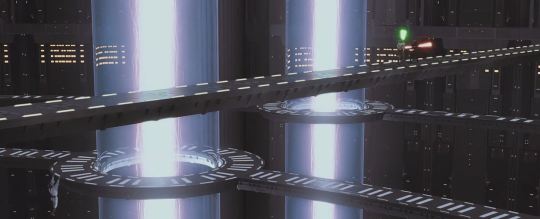
To Han’s death in The Force Awakens.
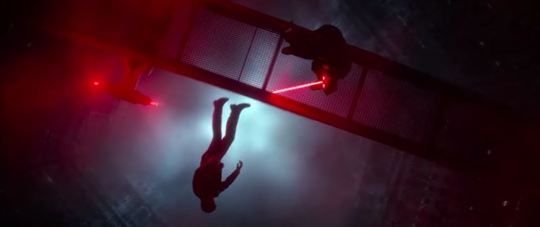
It is actually fitting to say that both scenes constitute an interesting framing for the Skywalker saga. Duel of the Fates is a very apt name for the beginning of the saga. Remember that Anakin’s name is etymologically “Ananke”, that is to say Fate, Destiny. Anakin’s fate is in the balance there, and the end result of who gets to become his Master and teaching him about the Force is key. Had Qui Gon lived, possibly, there would not have been any Vader. As for, Han’s death in TFA, the constant play of words between sun and son, and the not so subtle imagery of light and darkness, is supposedly all about Kylo’s fate. If Qui Gon’s death is possibly the first step towards the fate that will turn sweet lovable Anakin munchkin into big bad Vader, Han’s death is the counterpart of this scene, thus the first step towards big bad Kylo turning eventually into lovable Ben Solo. And just as it took three movies to realize the Fate of Anakin, it will take three movies to realize the Fate of Ben Solo. But I digress. Or not.
Because both stories, which interact like mirror images of each other, are perfectly hinged around two other crucial bridge scenes. One in ESB. And one in ROTJ. You know what I’m talking about, right?
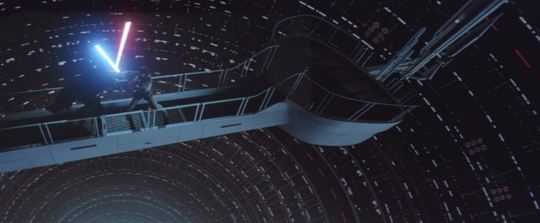
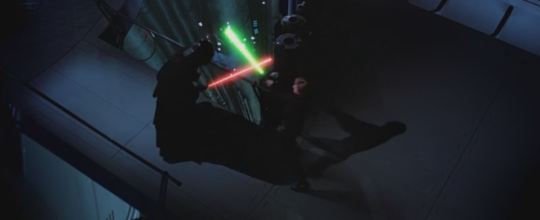
And these two are also counterparts. ESB’s bridge scene is Luke’s symbolic death scene: learning the truth about his father, and losing his hand, he would rather choose death and commit suicide. ROTJ’s bridge scene is Vader’s death and Anakin’s redemption, with Luke accepting the truth, Vader losing a hand, and choosing to save his son’s life. Even the placement of the actors emphasize this idea of mirror image. So Luke gets his Troll Bridge twice: he fails the test the first one, falling to the chasm and falling apart, and succeeds the second time around. Doing what? Throwing away his saber. Choosing love. Refusing to kill.
But I would also like to stress out that, from a certain point of view, Luke is not the only one who gets tested there on the Troll Bridge. Anakin, just like his son, also fails the first test and passes the second. In ESB, he has little to no love to offer and tempt Luke to his side: he offers the vague promises of the power of the dark side and ruling the galaxy together (which didn’t work with Padmé either). In effect, he is selfish, abusive, scarring his son physically and psychologically, and does not seem too distressed when Luke lets go and falls “presumably” to his death. In ROTJ, he chooses the losing side, standing against the Emperor to save his son’s life, which he knows, will eventually cost him his life. Thus, he is showing empathy and remorse, and saves Luke through a selfless act of love.
Yep, that is what the OT is about.
And, arguably, these two scenes constitute the very axis around which the other two trilogies are built. Hence my first “digression”.
It is also very interesting to note that in the four cases exemplified so far, the “bridges” in question are seemingly “reactor cores”, excuse my tech ignorance. These scenes are never about bridges out in the open, over a river, connecting two shores. They are always played out over a chasm, surrounded with energy fields, in dark environments with a possible fall into a bottomless abyss... Two possible interpretations:
because they are battle of the brains, moral battle of good versus evil within oneself. Inner battles. Think grey cells, cerebellum connections, as a map for these duels.
because they are battle of the heart. Issues of love. “core”
Honestly, I think they both go together!
Symbolically, they are your typical “choose the right path” bridges, the life and death, good vs evil bridges.
The many bridges of Luke
If you actually consider the OT, Luke’s journey is very much rhythmed by a series of bridges. Which might seem ironic for a boy coming from a desert planet with no water, and thus, no use or concept for bridges (besides rocky arch formation such as we see during the pod race in PM). But consider the last name GL decided to give him: SKYWALKER. That was not the orginial name he had chosen, right, since in first drafts Luke was called “Starkiller”. Consider then what a huge difference it makes when you move from a very martial moniker “Star/killer”, which is all about destroying life and light (and Luke actually comes from “light” etymologically speaking) to choose something that means: the one that walks the skies. Not flies. WALKS. And if you walk the skies, chances are you are walking on a bridge of some kind (like mythological rainbow bridges). Crossing a bridge is very much akin to walking the sky: you are suspended between heaven and earth. So even the name GL chose for his star family is all about “walking” on bridges.
The “bridge” moment in ANH is rather brief, but quite interesting. It is actually the “NO BRIDGE” moment, the one when Luke and the Princess find themselves locked out with no crossing, and stormtroopers shooting at them. This moment:
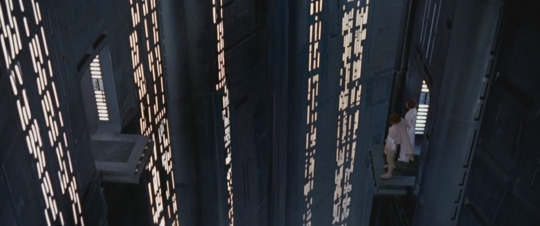
What does it reveal about Luke? His ingenuity, since he uses his farmboy utility belt to cross the bridge, but then also his instincts, the fact that he can rely on his roots (what he learned as a farmboy), his audacity, his ability to take a leap of faith (something that will play out later in his relationship with his father). But it also sets him apart as a different kind of hero. The NOT MY LUKE people should really pay attention to these details. Sure, he plays the hero, saves the damsel and everything, but in this scene they work together, she also gets to protect them, he trusts her with defending them, she is the one giving him a kiss for luck. This is very positive masculinity. Heroic, but not pushy. Manly, but respectful of women. Physical but also using his brain. Luke is such a dear.
In ESB, the big bridge moment is the one I already referred to. The moment of truth. Having these two characters on a bridge is very clever of course. It’s all about meeting in the middle. A bridge is by essence a balancing act. Can they meet halfway or will they cut all connections? Can opposites reconcile? Will they connect/reconnect? What better way to talk about human emotion and love than put them on a bridge, the very metaphor for communication, leap of faith, and the possible danger of reaching out to the other with your feelings?
But ROTJ goes even further with the bridge metaphor. Going with this when Luke reveals the truth to Leia...

To carry on with Leia and Han, where Han shows more of his emotions ans proves how supportive and selfless he can be when he is just there to comfort her in the end, putting away his jealousy and self-doubts:
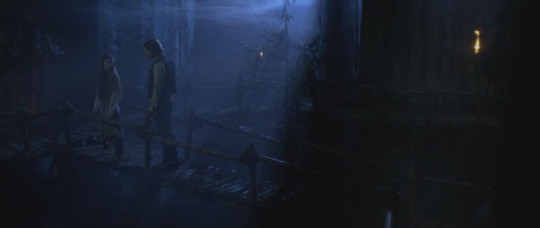
Followed with this, for Luke and Vader’s first meeting since ESB when Luke calls him “father” for the first time and tries to bring him back:
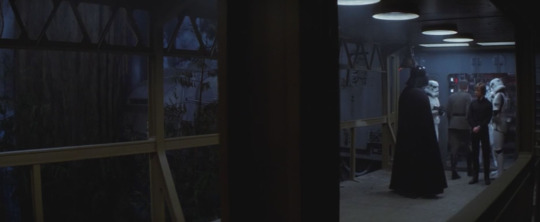
To conclude with the bridge sequence already mentioned when Vader chooses to be Anakin all over again.
WOW.
And where does it all take Luke? To a water planet with NO bridges. Seriously. When VII opens, Luke has chosen to sever, metaphorically speaking, all the links to others. As if he had chosen to destroy every bridge that could connect him to Leia and the rest of the world. And when we see him going about the island, there are no bridges. He jumps from one cliff to the other. Interesting thing is on The Art of The Last Jedi you get to see some of the art concepts that they had for Ahch-To that included a lot of variation on bridges:

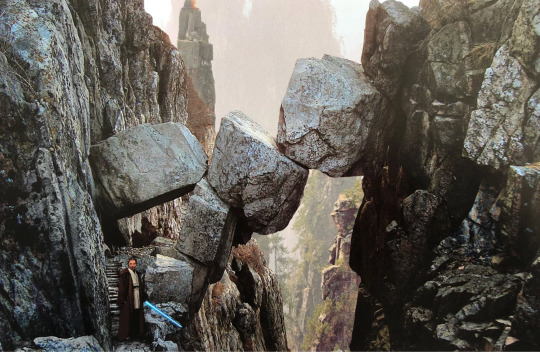
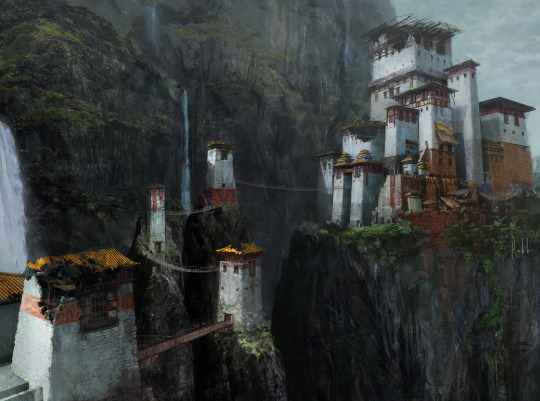
But eventually they went for the very design that removed any bridge from the place that Luke has chosen to spend the remaining days of his life until his death. Which is, I must say, a very good choice. He disconnected himself from the Force, he disconnected from people he loved not telling them where he hid, it made absolutely no sense to put him on a place that was covered with bridges. The bridges were meant to be burned.
That is... until one very last moment. Which is the perfect segway into my next chapter... Until the end. When he projects himself for one final face-off with his nephew. And that is a big bridge metaphor about reaching out across the stars. And we know that when Luke is on a bridge with someone he loves, this doesn’t mean harm or spite or revenge. Or even fighting. Bridges in SW are not so much about fancy duels as they are about love. Yep, even in PM. There is the love that Obi-Wan (yes, even a Jedi) feels for his master, and the need to extend and take care of a little boy that is all alone in this galaxy. A leap of faith. Love. Which means...
The ST is about crossing that bridge
Yes, there are bridges in the ST. And how Kylo and Rey are going to be able to cross over and meet each other. Let me explain. This happens at the end of VII:

Visually, it tells us that there seems to be no possible bridge between the two characters. Yet, the whole point is that they keep on looking towards each other. The bridge,aka the connection, is their eyes (mirrors of the soul yadiyada). And sure enough, comes VIII, and the bridge is there. WTF, will you say? What bridge are you raving about. Well... that one...
The Force bond.
And how do I presume calling this a bridge? Because...
It was I who bridged your minds
Interesting choice of words. But there it is. Put it as plainly and simply as you possibly can. The Force bond is a bridge, a spiritual bridge between Kylo and Rey. That’s quite something, right?
Which means that, there may be some physical crossing of some kind in IX. Now, I don’t want to be presumptuous and declare for sure, but it would seem like a logical concept. And on Vic Mahoney’s moodboard...on the left, some of the pictures seem very bridgelike...

And that’s also where I want to bring in that clever little TV kid show called Star Wars Rebels.
Take it to the Bridge
So Star Wars Rebels came before the release of TFA, in 2014, merely two years after Disney bought LF and therefore all the rights to Star Wars. Let’s look at what they did there and let’s wonder why. I don’t think that it was a random move on their part. They could, after all, have imagined something that took place right before TFA, or come up with the many adventures of Luke and the gang, or even spend more time on the Clone Wars, or go way back in the Old Republic. But no 14 years after ROTS, 5 years before ANH, is the time they chose. And came up with a totally new gang we had never heard of. Except that... well... the new gang got to meet A LOT of familiar faces. From all over the place: Hondo, Rex, Ahsoka, Vader, Leia, Mon Mothma, Bail Organa, Obi-Wan, Darth Maul, Yoda, Lando, C3P0 and R2, Palpatine, just to name a few... The point is that they get to meet people from the PT AND people from the OT. Thus (you know where this is going) bridging story lines. And, surprise surprise, what special name did they choose for their hero? Ezra Bridger. Gosh, that’s not even subtle, there. And by the way, what does Ezra mean? Helper. So Ezra helps bridging... aka, Star Wars Rebels helps bridging, connecting, if you will storylines. Towards a logical conclusion. And what is this conclusion, pray? The ST of course. And who stands on the bridge? Kylo and Rey.
Even better, what particular storyline did they preciously choose to keep to conclude this new Star Wars story:
the return of the Mortis Arc, balance
the World between worlds, and its very specific bridges that cross through time and space, and the possibility to alter the past/future, plus bringing back loved ones
looking for knowledge (last time I checked it was not so much about knowledge in the PT and OT). But Ezra’s story is all about knowledge.
love and sacrifice, saving the people you love (Ahsoka, Kanan, Ezra), and, come on, Hera and Kanan’s baby (by the way, Kanan is very reminiscent of Canaan, the Promised Land, so keep the prophetic aspect in mind)
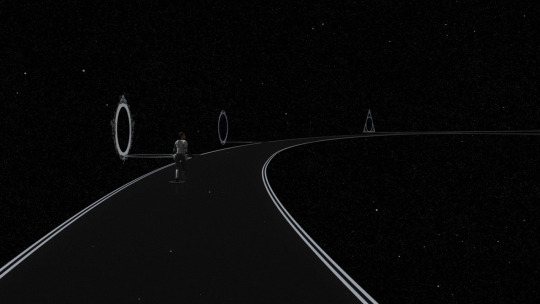
Again, how will it play out in IX? I have some ideas but I really can’t tell whether it will show up or not. There have been rumors about an artifact (very SW Rebels) that would require both Kylo and Rey’s powers. So knowledge. So possibly with notions of Mortis implied in there (balance). Love, sacrifice, we have discussed a lot. Remain the bridges. I can totally envision an important scene taking place on a bridge, with Kylo and Rey embracing, or running to each other, or holding hands while everything else around them crumbles. I can also imagine a bridge playing out with an intimate scene as we got in ROTJ in the Ewok village, something akin to the terrace where Anakin and Padmé first kiss on Naboo and finally get married. Again, the film has already been shot. So too late for that already and there’s a fat chance that it won’t even happen. But since we got a bridge of death in VII with Han’s death, we need a bridge of light.
Which might just turn out to be the symbolic bridge of Rey and Kylo coming together and finally uniting the light and the dark sides...
Leaving Simon and Garfunkel’s Bridge Over Troubled Water behind as a great Reylo vibe. Seriously. Reylo vibe, guys!!!!
When you're weary, feeling small When tears are in your eyes, I'll dry them all I'm on your side, oh, when times get rough And friends just can't be found Like a bridge over troubled water I will lay me down
When you're down and out When you're on the street When evening falls so hard I will comfort you I'll take your part, oh, when darkness comes And pain is all around Like a bridge over troubled water I will lay me down
#reylo fandom#reylo fam#reylo meta#star wars meta#star wars fandom#star wars parallels#star wars symbolism#star wars episode ix#bridges in star wars#reylo playlist
396 notes
·
View notes
Text
Once Again
We return. WicDiv is in the final stretch, and so is TWATD. The first of our two essays on #44, focusing on the issue’s echoes and callbacks. Spoilers – like oh so many spoilers – below the cut.
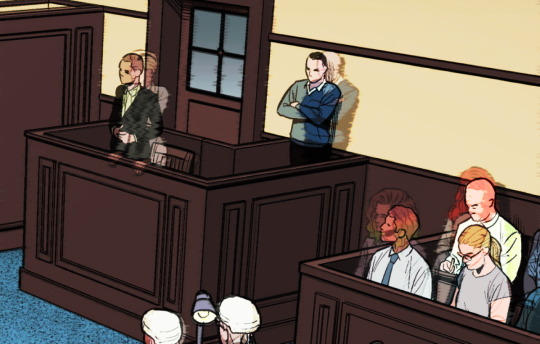
Alex: Remember issue #14 of The Wicked + The Divine? The Woden remix issue? I reckon, with a bit of ingenuity, you could use the same method – cutting up panels from elsewhere in the series, pasting them in new contexts – to make a fan edit of #44, front to back.
The issue is crammed tight with echoes of old images. It put me in mind of Avengers: Endgame, the way it’s constantly calling back to moments from the past twenty-one movies, and the criticism of that tendency as ‘fan service’.
In WicDiv, this echoing feels inevitable. The series has always had its repeating motifs. Going back to the very first issue, we get a whole host of phrases we’ll be seeing over and over: “Once again, we return.” 1-2-3-4. “I’ll miss you.” “Don’t.” Kllk. And images, too – from that very first cover, with its carefully-framed headshot echoed on the first page inside, something the first arc plays with again and again.
But what is the purpose of it, other than reminding us of something we’ve seen and loved in the past?

To answer that, let’s look at some specific examples – beginning, as the issue does, with Lucifer. From the very first panel of her, stood in a variation on her classic power pose, Luci is pretty much playing the Greatest Hits here. She lights a cigarette on her own inferno, holding a familiar eyebrow-cocked expression. She teases a finger-click, taking us back to the courtroom. Her threat of violence to Laura, framed side-on, recalls Lucifer’s murder in issue #5, and Ananke’s millennia of practice for that moment as seen in #36.
Lucifer wraps herself in motifs and echoes possibly more than any other character this issue, and it feels like armour. She’s the one member of the Pantheon clinging on to the lie of godhood, playing her role because it protects her from the consequences of what she’s done. She’s perpetuating Ananke’s cycle, and so she reaches for the easy iconograpy, the tropes, of the Lucifer myth.
It’s worth noting that most of these images are inverted. In that last example, Lucifer stays on the same side of the panel, but switches her role, from victim to the position of power. Even the colours of her outfit are flipped – white to black, blue to red – and her pose too, with arms up rather than down. Tim is going to be exploring the Two Girls in Hell sequence in his essay, so I won’t go too deep on that, except to point out that when Laura saves Luci, it’s by taking Ananke’s “I’ve missed you” and making it sincere.
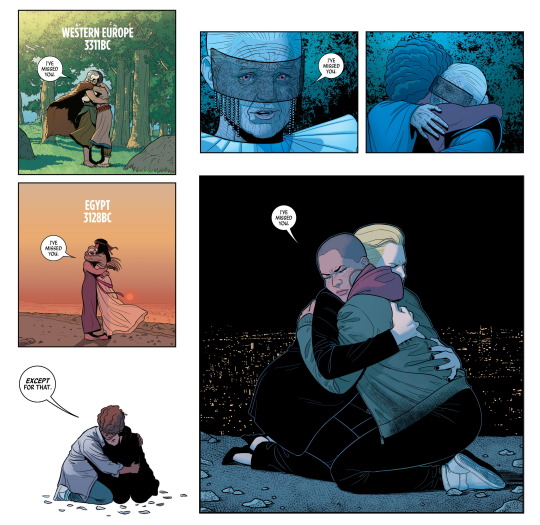
#44 does this over and over, taking a familiar motif and inverting the meaning. We’ve heard a lot of variations on “it’s okay”. Minerva, begging Ananke to tell her it’s going to be okay, a conversation we’ve likely all had with ourselves at some point. Its answer at the end of that arc, laid out in black and white: “It was never going to be okay.”
Here, it’s Dionysus who wields the phrase, and for the first time “it’s okay” isn’t a lie. Dio isn’t pretending that death won’t come for us all, or that Minerva’s situation is anything less than fucked. Instead, he’s encouraging her not to fear the inevitable. He isn’t offering denial, but acceptance.

Then there’s the other character interaction Minerva has this issue, which inverts something familiar in a much uglier way – her relationship with Baal. Time and time again, we’ve seen Baal wrap his arms around Minerva’s tiny frame. It’s indicative of the role he thought he played in her life, somewhere between bigger brother and father figure, but he now knows this was just a way of manipulating him.
In #44, Baal takes Minerva in his arms one last time, with very different intent. That big hand, able to cup her entire head, used to comfort or protect her, is used instead to smother. That tight embrace becomes a murder weapon. The contrast turns what could be a triumphant moment – this is the defeat of WicDiv’s big bad, after all – into an unsettling one.

Of course, it wasn’t much better the last time WicDiv’s big bad got taken out, as #44 is ready to remind us. The issues it draws from more than any other are the series’ first, and its midpoint. #22 and #44 are both stories about what happens when you beat the minions and get to the dark lord in their tower to find them helpless.
Here the repeated image – Laura with arm outstretched weighing up whether to kill the villain – acts as a kind of mental hyperlink. We’ve been here before. Twice before, in fact, just a couple of issues apart. (The second also introduced the idea of Woden’s kill-switch video release, which is vitally important to where this issue ends up.)
Both times, Laura hesitated – and then acted anyway. Our expectations are primed for the same thing to happen again. But, as any comedian will tell you, you set up pattern on the first and the second beat, then break it on the third.

This time, Laura hesitates – and is talked down. We see how much she’s grown as a character, because she’s put in the exact same situation, right down to the composition of the image and the people around her – Cassandra always hovers over her shoulder like a goth Jiminy Cricket – but the outcome is different.
I’ve mentioned fan service already, but there’s an alternative term I’ve been skirting around: payoff. A good final chapter (depending on how you view the epilogue) should bring together the threads of the story up to that point. That’s as true of WicDiv as it is of Endgame, as it is of a Dickens novel.
I do still worry about accessibility – how much of this comes across if you’ve only read each issue once, like a normal person – but maybe that’s not giving enough credit to the fantastic work of Jamie McKelvie + Matt Wilson making these images so immediately iconic, so mentally sticky, that you can recognise their vague outline five years later. As Tim suggested when I raised this question, these connections are likely kicking around in the subconscious of a more casual reader, even if they couldn’t put together the full serial-killer wall I’m making here.
There’s another thing, too. The fact that all these echoes are backing up feels indicative of what Laura is trying to do: breaking the cycle. Ananke’s six millennia-long plan is in its death throes, and this is one final twitch. Over and over, the issue shows that while the circumstances and tools might be the same, intent can change the meaning and outcome.
I suspect we’ll be free of echoes next issue, for the first time. I wonder if I’ll miss them.

Enjoyed this essay? You’ve got like 24 more hours to throw a bit of cash our way over at patreon.com/timplusalex, before we close down the Patreon in August. Think of it as a going-away present. Or a tip.
48 notes
·
View notes
Text
THE WICKED + THE DIVINE #29: WHAT IF THANOS JUST WANTED TO KILL HIMSELF?
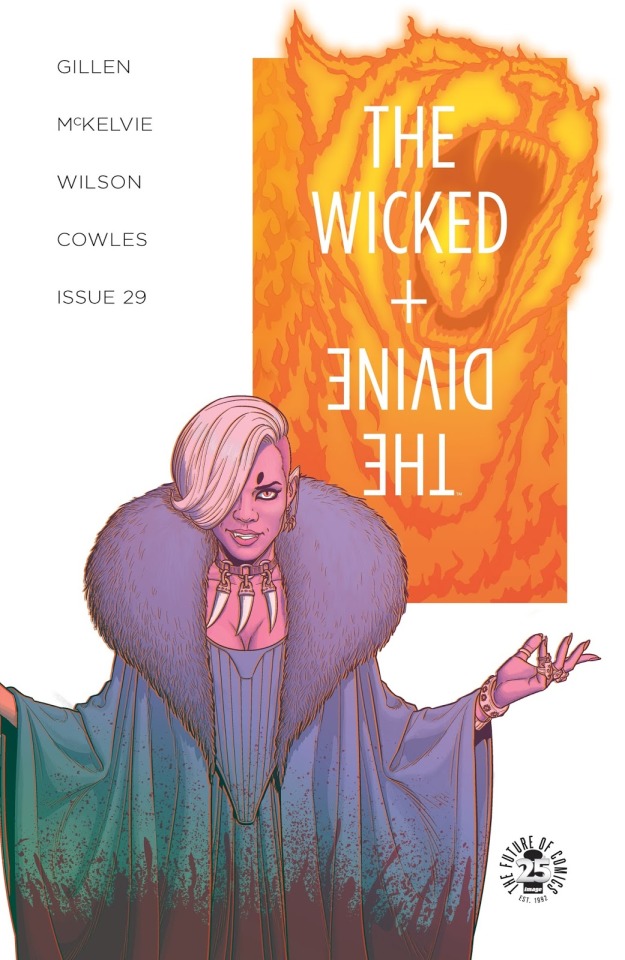
Sakhmet like a queen before her people, resplendent, except Can We Get Costumes Down Here A Second, Sakhmet’s got a little bit of Schmutz on her Gown.
UH HUH

It’s just one panel, but for the first time since her “death”, Laura speaks to us.
Though that’s as internal as we get, much of this issue ends up more or less from her point of view. We get Baal’s first performance and Sakhmet’s – which turn out to be a memory of Laura’s, followed later by an early a memory of hers with Sakhmet, her reflecting aloud with Cass about the nature of her relationship with Sakhmet. Then we follow her through an evening of unwelcome Pity Partying.

(I don’t know that I ever fully appreciated the presumption of tweeting a condolence at someone you don’t know. Wow is it awful.)
In the midst of all this we get the clearest sense of what Laura has been up to with Sakhmet, a combination of self-destruction – “It was like having an angel of death as a girlfriend” (yikes) and the search for if not understanding, connection -- “We got to be doomed together”.
(How many relationships could be described that way, I wonder, when you get right down to it? 'I feel trapped and being with someone else who felt the same made that temporarily more bearable.’)
I found myself wondering at some point what is with the issue of doubles – Laura trying to numb/erase herself with Fauxciver, Baal breaking in on Sakhnot? For me, it has the slightly sour air of decadence of a band just a hair past its prime. Instead of inspiring people or the gods to new things, there’s that sense of returning to old i.e. tired paradigms. It’s akin to Lucifer in 455 AD, the characters trapped, and Persephone similarly trying to escape, but doing so once again not by walking away and breaking the cycle, but by trying to get wasted on sad, derivative forms.
GOD GAMES
For as much as the issue centers on and around Persephone, in the background we’ve got every god but Baphomet active in a worrisome way.
Ammy, having once again fled the scene, plays dumb about what happened. That’s definitely going to end well. Meanwhile Baal not only embraces Ananke’s Snap Crackle Head Pop, but insists Minerva learn it. That’s definitely going to end well.
Elsewhere, The Morrigan admits yeah, Baphomet didn’t know what he was in for. That’s definitely going to end well. But she also notes that Cassandra did the same thing – which I would not have wanted to believe (#TeamNorns) except it’s followed by Cassandra explaining herself to her Norns.
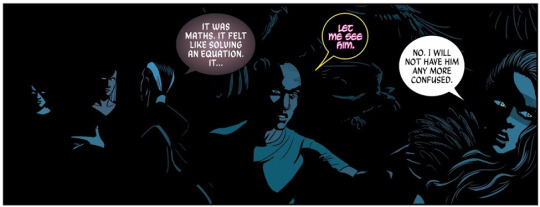
We don’t get a reaction or comment from them. Based on everything else, I’m sure that’ll end well. Just like Dio deciding to go full Buddha-Jesus savior or Woden, who appears in just one panel in the whole issue, making an offer to help out. Guys, he’s learned his lesson, he’s a helper, if you need recording gear or help nullifying a god’s ability, he can help. How could that not end well?
As much of the plot of this arc is a hunt for Sakhmet, it also reminds me of a whodunit, in that right at the start we meet all the possible killers (and the one we have to be worried about brilliantly played down), but with the twist that we don’t even know there’s going to be a crime yet.
THE ARTIST CONSUMED BY THEIR WORDS
Coming on the heels of 455AD, the other thing that stands out so strongly is the way The Morrigan, too, has turned herself from person into role, complete with strangely poetic diction – “the cat cannot escape the cage in her head”, “Morrigan and my foolish king have squabbled” -- her always fabulous costuming and this idea of herself as queen of the realm.
It’s not constant; we still get glimpses of a more modern voice.
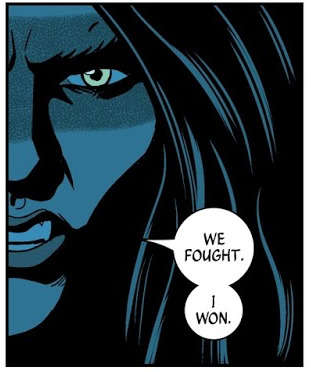
But in general Marian, too, seems more and more lost to her personas. George and Martha, sad sad sad.
13 notes
·
View notes
Text
Reason Number Two! {{Major Spoilers}}
Kinda goes alongside reason 1>>> The second reason why I think Nick isn’t an evil prick is because he is, by nature, a bloodthirsty, homicidal, bay-shit crazy demon who thinks nothing deserves the sweet release of death. In short- he’s the Malachai. {{but he’s not JUST the Malachai, now is he?}}
I don’t know why this is so hard for some to grasp, but I’m serious on the whole he-acts-like,-a-million-times-better-than-any-of-his-fathers-before-him-thing. 100% serious about him being a big ‘ole Malachai. If you don’t believe me, google it. Also, if you were your own worst enemy ((literally speaking)) then you wouldn’t be happy either ((read the bottom if you haven’t read CON)).
Honestly- I think it’s easier to accept the fact that he’s a special bean rather than swim in Denial River.
Sorry to be the Bear of Bad News, but Nicky Gautier is a blue-eyed demon boy who the Simi loves and wishes she could eats. It’s a thing, people.
Key words being “demon boy.” I can’t stress this enough. And for those of you who haven’t read CON yet, allow me to educate you on the big bad nightmarish hatred-infused bloodsucking demon.
1.) they are the most hateful, angry demons. Period. They don’t give a fuuuuuuuuuuudge about who they hurt. The only time they’d care is if they personally wanted you dead {which is basically almost every being}. Ever.
2.) they have always been the most feared species of demonkyn. Ever since Monakribos curse his sons, to be exact. You know, beginning of Time and stuff.
3.) they are HELLA HELLA MACHO POWERFUL!!! I mean VERY POWERFUL. like, up there with gods and such.
Major powers include: ATTENTION!! THESE ARE COPIED FROM NICK’S (CON) WIKIPEDIA!! IT IS NOT MINE ORIGINALLY! I DID NOT WANT TO TAKE THE TIME TO TYPE THIS OUT, BUT IT IS FACT CHECKED AND WHAT NOT! PLEASE DON’T GIVE ME CREDIT OR WHATEVER FOR TYPING IT! hehe…anyhoo-
-Malachai Abilities:
Demon Glamour: Nick, due to being born from a race that were the consorts and soldiers to the dark gods, has extreme charisma and very good looks.
Demon Summoning: Nick was capable of summoning Caleb to an alternate universe and back again.
Divination: Nick has a talent for scrying. This means that he can see the past, present, and future on any reflective surface, though he seems to favor his black scrying mirror.
Empathy: The Malachai, being a creature born of hatred, has empathy so that it knows how to emotionally destroy his enemies. Nick uses this ability subconsciously to help his friends.
Enslavement: Nick is capable of enslaving a demon by saving his/her life. He accidentally did this to Zavid.
Eternal Enslavement: Nick is capable of tying an enslaved demon’s geish (or essence) to his powers, meaning that the demon will always be enslaved to whoever has his powers. Adarian did this to Caleb.
Eye of Ananke Absorption: By absorbing the power in the Eye of Ananke, Nick is now able to see all possible futures, instead of only seeing what is available in the Ether.
Fate god: Nick is capable of using the Eye of Ananke, something only fate gods are capable of doing.
Fear Factor: Malachai demons are the most feared of all demonkyn.
Elemental Control: Darkness Darkness Generation: Nick is capable of controlling the element of Night (through Noir). This allowed him to defeat Alternate Thorn with ease.
Electrokinesis: Nick is capable of creating lightning bolts.
Fire Blasts: Nick has the ability to produce extremely powerful balls of flame. These seem to function similarly to God-bolts and can disintegrate a Dramonk with a single hit.
Emotion Feeding: Nick grows stronger when in the presence of hatred and malice. When he went to prison his power increased.
God-killer: Nick is a god-killer in the sense that he is capable of killing gods without destroying the universe.
Healing: When Nick first tapped into his demonic heritage, his gunshot wound healed instantly. He also seems to be capable of healing others, such as when he healed Little Simi in the alternate universe.
Hidden Fate: Fate gods are incapable of using their innate abilities to see Nick’s true fate. When Acheron looked into Nick’s future, he saw Nick happily married with children instead of his Malachai heritage.
Immortality: Nick is immortal in the sense that he will never age. Though he could be killed by severe trauma, this is highly unlikely as it will upset the balance of the universe.
Immunity: The Malachai is immune to Chthonian powers as well as Acheron’s ability to make people desire him.
Languages: Nick has the ability to understand and speak any language. This extends to the Primal Language, which most high-level gods don’t know.
Lie Detection: Nick is implied by Ambrose to have this.
Magical Physiology: Nick’s blood, bones, and organs are magical by nature and can be used in several dark spells, such as when Xenon used some of his blood to send Devus’s master away.
Malachai Form: Nick is capable of unleashing his inner demon. In this form he has indestructible armor, claws capable of ripping enemies to shreds, fangs, vastly increased strength, speed and reaction time, and wings.
Mind Control: Nick is able to directly control the minds of others. This is seen in Instinct, where he confused the paramedics as well as the police officers.
Necromancy: Nick was capable of destroying the zombies the Mortents raised with a simple incantation and it has been said that once he receives enough training, he would be capable of restoring a soul from Azmodea, something that is said to be Jaden’s specialty.
Omniscience: Due to his connection to the ether, Nick can be considered omniscient with him being able to know anything at any given time.
Perspicacity: Nick can see through all disguises. The first time this ability manifested, he was capable of seeing Acheron in his “Harbinger” form, something even other gods are incapable of doing.
Pith Point Moving: Nick is capable of moving Pith points, something the Arelim (guardians of Time and Order) believe to be impossible. It is possible that he inherited this power from Jaden, seeing as Jaden does believe it to be possible.
Poisonous Blood: Nick’s blood is poisonous to Arelim.
Power Absorption: Nick can absorb the power of other beings by drinking their blood.
Presence Shielding: Nick can hide what he is to the extent that he appears human from others. This power works on Chthonians, demons, gods and psychics.
Realm Traveling: Nick can punch a hole between dimensions. He did this to travel from Agonia to his apartment.
Shapeshifting: The Malachai can theoretically assume any form that he wants. Adarian was able to pose as a 13-year-old schoolboy and later a middle-aged convict despite being thousands of years old.
Silkspeech: Nick can manipulate others using this power. It works by targeting aspects sensitive to others, such as when Zarelda used it on Nick by preying on his low self-esteem.
Spell Casting: Nick was capable of exchanging Devus’s soul with the girl Devus killed to make a deal with his master. He was also capable of summoning Menyara from a hell-dimension.
Super Strength: Malachai demons are incredibly strong, capable of overpowering gods, even the primary ones, with ease. Adarian used to tear lesser demons to shreds with his bare hands.
Supernatural Awareness: Nick can sense the presence of other supernaturals with ease, such as when he sensed Kaziel (something neither Caleb nor Xev was capable of doing).
Telekinesis: Nick can move things with his mind. His control of this ability, as of Invision, is weak at best.
Teleportation: Nick can instantly travel to any location.
Temporal Awareness: Nick can sense when someone is altering time. He can also see any changes made to the timeline, seeing as he remembers both the altered and the unaltered timelines.
Sephiroth Abilities:
Burning Light: Whilst trapped in Azmodea without his Malachai powers, he destroyed a portion of Noir’s forces by becoming engulfed in light. Since Malachais are creatures of darkness, it can be assumed that this stems from his Sephiroth heritage.
Healing: Malachais are incapable of healing, so it can be assumed that Nick’s ability to heal Little Simi stems from his Sephiroth heritage.
Other Abilities
Courage: Nick is capable of overcoming his fears and stand up to beings like Acheron, Noir and Thorn.
Indomitable Will: Nick is capable of maintaining silence under torture (as seen in Illusion when Alternate Acheron made him fight in gladiatorial-like matches against an Aamon).
Intelligence: Nick’s intelligence has been commented upon by numerous characters throughout the series. He got perfect scores on the admittance test to St. Richard’s, which is a very prestigious school.
——END FOR NOW——
If you didn’t take the time to read all that, I understand. BUT DO YOU GET IT NOW?
Notice the words SEPHIROTH POWERS above. That’s right. He’s not just a demon. He’s not just annoying and stubborn. HE’S ALL OF THE ABOVE.
Not so unreasonable for “no reason” anymore, huh? If you still think he’s an A-hole, I get it still. He really REALLY can be. But he can also, and should be according to history, be a billion times worse.
More to come later, but this post is hellaciously long enough.
47 notes
·
View notes
Text
Seeds of thoughts : Wicdiv #36
Hello everyone ! Sorry for the lack of SOT last month. What happened was… I didn’t know what to say about the issue that hadn’t already been said. Sorry. Happens to the best of us. Anyway, we’re back with an issue that’s practically begging to be analysed, so that’s good. And just a reminder, if you’d like to help me not be broke, you can make a small donation here.
Thoughts and spoilers under the cut, you know the drill.
THROUGH METICULOUS ANALYSIS OF HISTORY
As expected of our wonderful fandom, some of my fellow bloggers (hi, @twatd and @myfirstsearchengine) have already started doing god’s work and untangle the absolute deluge of information we get in this issue. Bless their souls. But for me as always, especially when it comes to formalist devices, I find myself more interested in how things feel than what they say. That doesn’t mean we should bypass the analysis of the construction to get directly to a resulting, all-encompassing feel of the issue (otherwise, what would be the point of these posts ?) but I think it’s always a good start, especially with information-rich issues like this, to wonder what may be the big picture that’s so painstakingly painted through this abundance of individual elements.
So, how do we emerge from this issue ? Of course, everyone’s feel will be different here, but I think one popular realization will be just how fucking long six millennia actually is. On first read, as I flipped through the first half of the issue with increasing speed, I kept reading dates so far away from anything I could conceptualize they meant nothing to me until we thankfully reached the Anno Domini part of the program and I regained footing in time. Add to that the fact that I would be unable to point on a map to a good dozen of the places mentioned and you get… a recipe for emotional detachment. Of course, one of the joys of this issue is to go back and pick out the multiple details hidden in each panel, to cheer every time Persephone retaliates, to unravel patterns, to marvel at the outfit design and background changes, all these elements that actually allow us to connect with what’s going on. But as always, the interface between a reader and an issue is its whole and not a sum of its parts. Our emotions express themselves faster than our thoughts, meaning when we go back to identifying those parts, our connexion to the issue is already formed. As it happens, this connexion is to a gallery of nameless, often headless figures that have nothing in common if not for the pattern they’re repeating, and not to the individuals that form this pattern. A state of mind that’s probably very similar to the one Ananke entertains during all those recurrences. A state of mind she HAS to keep in order to maintain her own pattern.
Is the message this repetition has to impart us just that, a form of numbness to these killings, the taste of an endless battle and the suspected pointlessness of it all ? I think there’s a bit more going on here. Let’s try to connect the first half of the book with the second one. A priori, they seem disconnected. But the fact that Mothering Invention’s device seems to be the juxtaposition of past and present storylines means the creators are trying to establish some sort of echo between the two. In issue #34, the creation of the head sacrifice is paired with its discovery by the main characters in present time. Issue #35 is a study of two Minervas, and the circle of plotting and murder they’re trapped in. Issue #36 is the study of two monsters.
Is the wheel page in the middle of the issue describing Ananke or Baal ? The ambiguity is definitely not accidental. And if the construction of the two halves seem to be complete opposite, that probably not a coincidence either. The most obvious mirroring are the red pages, an entire page for a death, compared to the first half which crams six or more deaths per page. But really, that’s just the beginning of the parallels. The first half is made of a regular grids of small panels in which you can barely distinguish faces, while panel disposition in the second half is as irregular as they come, but focus on large, detailed panels, with Baal’s figure in particular blown out and dominating each page. The first half is all variety of colours and tones, while the second one is painted in an overpowering red. In the vast majority of panels, Ananke is depicted from the side, entirely focused on her task, while Baal is always facing the reader, sometimes almost as if he was addressing us directly instead of Persephone. But the most textual opposition is of course how much justification and explanation there is on Baal’s part, while Ananke, past the first page, doesn’t say a word. In his first apparition, Baal is even doing the Hamlet routine of holding a skull before starting his monologue. These two characters seem like they couldn’t be more different, yet the comic links them through this middle wheel page. Baal is all justification and self-aggrandizing, Ananke seems content with her selfish motivation. Baal gives an entire page to the weight of taking each life, while Ananke rarely expresses anything. Which is better ? It doesn’t matter, I think is the takeaway here : they’re both killers. And if you peel off the surface, they’re both exactly as selfish, cruel and inexcusable.
This doesn’t say great things about Baal. But I don’t think it says great things about Ananke either. Baal is arguably being manipulated into killing – does anyone buy the reality of the Great Darkness at this point ? – and is not nearly as jaded as Ananke is after six millennia. Is the only thing separating them time and experience ? If we come back to this first half, many people have noticed that Ananke seems to be consolidating some techniques and get more efficient overtime. But is that really true ? I’ve pulled the numbers : in the first third of her career, Ananke screws up about 13% of the time ; in the second third, 18% ; and in the last third, 9%. Those are remarkably similar odds. Can we even say she’s getting better at this ? Even if that’s true, the present recurrence seems to demonstrate that she’s never safe from a major setback. Nothing separates her from junior murderer Baal. She would have Minerva – and so, herself – believe that it will always be okay. That she’ll always win, in the end, even when she fails. But that’s simply not true. When she’ll fail for good, she’ll be done, just like Baal. And then these millennia of deaths, hers and Persephone’s, will mean nothing.
It’s remarkable that both Ananke and the comic would have us looking for more than there is in this litany of murders ; dumping truckloads of apparent information on us and inviting us to raid them for parts. And there is a part of me that definitely wants to do that. Because information and particularity gives meaning, it hints at more explanations, as a way to make sense of it all. But deep down I know that there will never be enough meaning in those panels for me to be satisfied.
Through this issue, it’s as if the comic is pulling all the stops on itself : it doesn’t matter how much it goes back in time and gives us fragments of this “big mystery” it’s set over the course of the previous arcs. Because it can give us everything, every recurrence there ever was, and all those murders will never mean more than what they are : murders. It doesn’t matter if it’s your first, your tenth or your sixty-fifth. It doesn’t matter if it takes you a whole empty page or get crammed into one-sixth of one. It’s still murder and you are still a murderer. And when you fuck up, everyone will cheer. And if you know it, that doesn’t make you nobler or more experienced, it just makes you an even bigger asshole.
I said one thing about this issue was how much it gives us ; yet, at the same time, it’s the comic’s admission that it gives us nothing, or at the very least not what we’d really want, because it doesn’t exist. What we see is all there is. The only thing separating Baal from Ananke is that they are fooling themselves in a different way. And again, there’s a part of me that’d really want to fool myself with them. With almost ten issues of Wicdiv remaining, I feel bad for giving it an early conclusion, but here it is : whatever is “really” going on, whatever the bottom line is, it doesn’t matter and never has. All there ever was is a desperately, cruelly simple tale of scared people. It doesn’t make them excusable. But it certainly makes them human.
WHAT I THOUGHT OF THE ISSUE
As I said, this issue stands out by how rich and poor in content it simultaneously is. As is often true of high concept issues, in terms of analysis, it immediately gives you something to discuss, but it doesn’t necessarily give you much more than what you first saw. What’s good about this issue is also what limits it, and makes it a nice, but also kind of one-note experience. As such, it compares unfavourably to other highly formalist issues like issues #14, #23 and especially #27, all of which were more evenly structured and solid in concept. I almost wish this issue had taken its premise further, and given us a cover-to-cover wall of Persephones. The parallel with the Baal scene is thematically rich, but it does give the feeling that the main storyline is stumping a little bit, and that the main reason we’re getting all those flashbacks is to artificially lengthen the comic.
That said, I’m not particularly disappointed by this issue either. It always takes a Wicdiv arc a bit of time to find its footing, and with the high concept flashback out of the way, the rest of the arc should set about its cruising speed. Plus, you can absolutely feel the amount of work that went into those pages, and while the result should be able to stand on its own, I really don’t feel like badgering on what was clearly hell on earth to build. Yes, it’s a borderline masturbatory nerdfest that saw the point of diminishing returns and blew it at full speed while laughing maniacally, but I think we can allow at least one of those in the Wicdiv run. It’s the kind of issue that I don’t see myself forming a strong attachment to, but I’m still glad it exists. And for what I’ve seen, aside from isolated opinions, that seems to be the general wisdom.
So let’s turn to the one part of the issue that DID attract the wrath of the Tumblrdom : Laura’s pregnancy. Boy, did you kick the hornet’s nest with this one, guys. I find it funny that as the fandom’s resident grump, the first big outcry we get about the Wicdiv run is one in which I find myself standing firmly with the creators. And since it seems I’m kind of alone on this one, allow me to make the case that as a story development, Laura’s pregnancy is… OKAY.
Let me first be clear : I’m not saying I’m happy with this development. Until we get the full picture of how it’s been handled, I’ll really have no opinion on the matter. What I do believe is that at this point, there is no reason to condemn Laura’s pregnancy as an inherently wrong move for the comic. I absolutely get why there was such a knee-jerk reaction from the fandom : it’s so, so very rare for a pregnancy storyline to be well done, to say nothing of a teen pregnancy storyline. For every one of us, the very mention of peeing on a stick is enough to bring back to mind dozens of female characters ruined by such a creative decision. So I get why people are being cautious ; I am too. But on the other hand, I find it really premature to set ourselves for outrage and disappointment.
From what I can tell, a lot of “oh HELL NO” reactions are rooted in the belief that this twist diminishes Laura’s characterization and strips her of agency. But personally, I see this development as completely in line with her character as previously established, and I don’t think she’s less of a subject for it.
For a start, we have to consider how much has been going in Laura’s life aside from her pregnancy. We don’t know how long she’s known about it, but reasonably it should have been around the end of January. She did a LOT of shit in-between, and none of it played as a direct consequence of her being pregnant. The way she describes her state is almost tangential, a Colombo-esque “oh, and one more thing”. Rereading her actions in light of her pregnancy doesn’t mean we should interpret it all as revolving around it ; if we do that, we are the ones stripping her of agency.
@immoralitea made another interesting argument : that the pregnancy was cheap cope-out to Laura’s suicidal behaviour by giving her a reason to live, thus derailing her entire battle with depression that’s been established as key to her character ever since the first act. That’s a compelling point, but I read Laura’s pregnancy completely differently : as another profoundly self-destructive behaviour. And I don’t know if that’s controversial to say, but in my opinion many storylines would benefit from addressing head-on how much self-destructive tendencies are a component of teen pregnancy. Pregnancy will put your body through the grinder, alter the course of your life, and alienate you from many people. And that’s if you’re lucky. If you aren’t, it’s also going to saddle you with an abusive partner or make you dependent on exterior resources for many more years. The last thing to get you through a depression is pregnancy. Of course all of this would be moot if the author didn’t realize it, but I think he does : nothing in Laura’s behaviour indicates she’s willing to change it for the sake of her potential child. On the contrary, she’s endangering it and herself by engaging in more self-destructive behaviour. That’s also why I think the “some of you will hate me for it too” line that also got some readers upset shouldn’t be read as the author’s opinion that Laura is to be shamed for her pregnancy ; for me, it reads as Laura’s opinion about a behaviour she sees for what it is : another way to destroy and hate herself. And just like she said before, she wants people to hate her ; it validates her suicidal behaviour. She’s doing everything she can so we will hate her, including getting pregnant.
Another clue in that direction is the way she discloses her state to Baal : when she says she “wants to live” it isn’t because she’s pregnant, but because every person battling with depression is torn between compulsions of life and death. And I may be mistaken, but I don’t think she wished to reveal her pregnancy to Baal at all ; I think she’s simply appealing to his “man of the house” self-image in order to be spared. From beginning to end, this is about her. Hell, she still has over two months to decide if she wants the baby at all.
Now I’m not going to lie, I’m not a fan of the over-symbolism of the goddess of death and rebirth being both suicidal and pregnant. And yes, if you ask me, I’d much rather have Laura get an abortion, because I don’t see how carrying her pregnancy to terms would benefit her in any way. But if Laura’s previous characterization taught us something, it’s that characters in Wicdiv rarely do what we want them to do and what’s objectively better for them. The gods have made the wrong decisions on drugs, cheating, dating, killing, trusting, overworking, and everything else under the sun, and we went with it, even if we weren’t happy about it. As I see it, pregnancy shouldn’t be over the line just because so many hacks have poisoned the well.
Again, maybe this storyline will develop for the worst and all I’ve said here will read as ridiculous wishful thinking in hindsight. But as of now, this plot development is simply this : a plot development, one that’s believable, in character, potentially interesting, and I think we should give it a chance. And if I end up being wrong… I promise I’ll write the mother of all takedowns.
71 notes
·
View notes
Text
Day 2 WicDiv Challenge 2.0

Day 2: Favorite Stand-alone Issue
I like all of the specials, but this one being so late in the book’s life meant that Gillen could give us more information than usual, even if some of it was hidden.
I just love how this issue played with my expectations. With all we knew about Ananke, my mind automatically assumed she was the killer, but she wasn’t. Then I kept trying to figure out who the heads were, but it didn’t add up.
Then Mothering Invention happened, and it all made sense.
I also love how we got so much more than before, part of it being prose meant that we got so much more info, and got to know this pantheon better than the previous ones.
16 notes
·
View notes
Text
My overall thoughts on the wicdiv christmas special

it was so beautiful to see all of our favorites back in the comic. with inanna and baal’s story i felt a connection there because i’ve been baal in that situation while struggling to understand my sexuality and not knowing what to do. but it’s beautiful and it’s sad and i wished that they had the chance to reconcile because they truly loved each other.
it’s so ironic to see sakhmet calling lucifer a bad person. but i guess this is before she got to crazy and ate her dad. lucifer also gave a different side to us as well. she has the “ lucifer “ face where she’s the bad girl of the pantheon, the serpent, and the deceiver. but she’s also eleanor a girl who cares about her friends and was especially sad when hazel was revealed to be amaterasu. because originally, lucifer didn’t want this, and even when she was alive she probably felt a bit slighted by the 2 year mark. also hazel’s fashion is killer, like i wish we could’ve seen more berets.
okay now with the umar and cameron story. i just felt so overwhelmed by how handsome umar was. like oh my god that hair! and the beard! and those eyes! so full of life and rested like he actual slept for once! it is also sad because it reminds me that he is dead dead. but even then, he always wanted to help people. i wonder what happened to trish and linda. more importantly, does the morrigan leave random messages in the leaves when she’s going to perform? or was umar and co special? also the puns with cameron and The Gothness of everything was a blast. i missed it, it’s funny and reminds me of old times.
we got tara again! even though she’s sad. it makes me even wonder why ananke picked her out of everything seeing as she knows it would be difficult for her. she admits it to herself that she was cruel in telling tara that you won’t be affected by it. when you’re bullied people always tell you that they are just words and you can’t be hurt by words. but that’s not it. being someone who was bullied all throughout middle school is exactly why i hated that whole point of my life. and even though i got through it, it was because i had to deal with it in silence instead of talking it out with friends and families which would just be me getting scolded. i feel for tara alot because all she wanted to do was make music and get her sound out there, i really wish she could’ve went to dionysus’s hivemind party so we could see her and get to know more about her.
finally laura! and proper laura with narration inside the mind! she’s totally bisexual and totally would’ve hooked up with lucifer if given the chance.
overall: amazing, spectacular, heart-warming and yet breaking.
14 notes
·
View notes
Text
wicdiv #32 post
this is fine. i’m alright with the events that are unfolding currently.
big spoilers and all of that
ok but honestly the first page is really fucking funny and good. emphasizing how persephone’s in this rut she can’t get out of by reusing panels but also using those panels to accentuate the punchline. really good.
i’m sure you all already know this but woden is a slimy little man who i do not like
dio thinking of the other norns after cass sort of restates that he’s already (mostly) gotten over the fact that he’s not a person she’s going to love
god that “i can save everyone” page is good. really great movement
“the red shoes” is a kate bush ref.
i always knew sakhmet wouldn’t give a fuck about persephone killing ananke if they’d just told her!
i think persephone and sakhmet getting a tender moment before things go haywire emphasizes that there was some care for each other there. i think persephone really did love her; sakhmet is different, in that i think she cared, but she was also operating on such a different moral code of predator/prey that she was still willing to throw it away if persephone demonstrated that was needed.
persephone’s statements here are also, i think, her at least attempting to be at her best- her justifications feel real, but they also feel kind of forced. i think she’s saying what she wants to be true, what she’d like to perform in her actions, but doesn’t always- particularly in her statement about who deserves to be hurt. she says you shouldn’t hurt someone who doesn’t want it, but she does that all the time, even in this issue with cass! i think that’s how she wants things to be, not how they really are.
the coloring effects in the entire dio sequence are so great- especially the fizzy, electronic effect to emphasize woden’s presence and taking his powers. matt wilson is a godly being who we don’t deserve
the 1234 bit works doubly because it’s a callback to dio’s debut issue, but also because it’s a heartbeat and we know dio has heart issues.
“maybe i was wrong.” :( i love him and i already miss him
one of the sad parts of dio’s death here to me is that woden’s line about it being an “astounding act of altruistic yet futile heroism” is...kind of correct? dio doesn’t even stop woden, woden runs off. dio did all that for basically nothing!
it’s also kind of horrifying that people were calling for an encore when he was pretty much already gone, and that he was operating that way (”one more time”) in order to do that for people.
the other thing that strikes me about dio’s death is that it’s kind of a soft one; we get the valkyries as the maenads, but they don’t even beat him up that much (or tear him apart) before he collapses. and he’s not even 100% dead, technically. it’s basically giving him the gentlest send-off possible while still mostly killing him.
cass not being affected by woden using dio’s powers because she’s a critic who can see that he’s plagiarizing is amazing.
“it’s not as if that was what i was trying to do, cass.” then what were you trying to do?? why did you need an army??? where did you go??? god i hate the slime man
morrigan refusing to come help because it’s at persephone’s apartment is to some extent amusingly petty until you grasp the consequences. maybe she could have helped things settle down safely! maybe persephone could have gotten away to cass and dio! maybe minerva wouldn’t have had to kill sakhmet! and morrigan didn’t go because she has a grudge! someone pointed out to me that mini might be rightfully pissed at her for this.
on a side note, at the end of this issue the wheel looks parallel, so i would not be shocked if morrigan and baphomet go next to continue that, and i would not be shocked if reacting to recent events- especially dio dying just after he tried to help baph- brings them back into the plot next arc.
i’m so happy sakhmet got that “pussy-whipped” line in before she died, i’m 99% sure kieron was saving that on a doc somewhere
i already talked about sakhmet and persephone’s relationship dynamic before to the point where it really covers the scene before sakhmet dies too, but the panel where persephone can’t make herself kill sakhmet and looks like she’s about to cry is honestly really sad. she really felt something deeply for sakhmet.
persephone’s face looks like it has two matching red streaks on it from sakhmet’s hands and it’s a really cool image/detail.
when will minerva be safe and have a stable life. never i guess. it’ll be good to see her as a more major player in the last year of the book (presumably) but we also already know she’s getting into alcohol so i don’t expect it to be fun.
this entire cass/persephone argument kills me but it’s also brilliant writing in what’s not said- this entire conversation would not be happening if cass’ best friend and persephone’s girlfriend hadn’t just died. i think cass takes the excuse to be angry at her with the fact that persephone didn’t get dio to the hospital as an excuse, although i think she also knows that persephone was fighting sakhmet and couldn’t, but she’s too emotional to act better. and persephone feels the same way, so she goes ahead and continues the argument, and it gets more and more awful until persephone says that line about dio, which is, uh, jesus? i think they’re both going at each other with the first thing that comes to mind, and they don’t really feel any deep hatred for each other- just frustration. and in their current states that’s enough to rip into each other.
i also wouldn’t be shocked if persephone blames herself for spending so much time with sakhmet and not realizing she could be a killer, and if cass blames herself for not stopping dio from doing the party and not noticing woden was up to something. so. there’s that.
anyway, uh. time to meet pink woden?? i hope??
if we meet pink woden i hope they kill standard woden and take his place. please remove him from this comic. i do not like him. thanks.
i was wrong about it being fine. it is not fine and i am sad. thank you for reading
29 notes
·
View notes
Text
The Prophet of 'No' and the Priest of 'Yes': the Ambiguous Transcendentalism of True Detective and Hannibal's Neo-Pagan Priesthood
(What follows is an examination of the intertextuality of Hannibal and True Detective along with apposite philosophical thought. So, if you haven't watched Season 2 of Hannibal and Season 1 of True Detective (but intend to) be aware that this post has a couple of spoilers.)
NBC's Hannibal and HBO's True Detective were, for me, the most captivating shows on television this spring, and by a wide margin. Their acting, writing, direction, cinematography, sound, and overall artistry were magnificent, but it's the way these supported the development of vital characters who embodied complex philosophies that set them apart functionally from franchises of similar stature (Deadwood, Madmen, et al.).
Both series center on a string of haunting ritual murders and the liminal hunters that circle our flock and pick us off one by one like wolves in the night. Critically, however, where Hannibal is named for its villain and takes us on a season-long tour through his thoughts, behavior, and relationships, True Detective doesn't reveal what it calls the "monster at the end of the dream" until its final episode, and only at the very climax of the finale do we hear what we're essentially told are the ravings of this quasi-religious lunatic, barely audible as they echo through stone corridors of his strange labyrinth. His creed and code are thus presented as mere appetitive grunts of a minotaur whose body may be human but whose head (and mind) are bestial and inexplicable.
True Detective's namesake and focus is rather the killer's antagonist, Rustin "Rust" Cohle, who is somehow portrayed masterfully by the real-life version of Michelangelo from Teenage Mutant Ninja Turtles, Matthew McConaughey. Rust is an over-read skeptic who peers out on a universe of death and decay and rejects its basic premise, grimly resigned to the unavailability of transcendence beyond time's "flat circle" (as the show's villain, the Yellow King, glosses Nietzsche's notion of the "eternal recurrence of the same") and the inescapability of brutality, despair, pain, and death - the absurd birthright of consciousness, which is little more than Fate's miserable bastard. What makes Rust loveable despite the fog of gloom that seethes from his mouth and envelops his every scene like Pig-Pen's filth-cloud, is his unwavering desperation for this transcendence he is certain is impossible, the integrity of his universal depression that doesn't soothe itself in the sardonic humor and supercilious irony of so many hipster cynics. Rust is an abstemious monk who waits without pleasure or distraction for a dawn he knows will never come, an inconsolable bereaved father who curses his own glaring flaws in endless self-flagellation and tries to set the world to rights as best he can.
Juxtapose the slippery-smooth marble edifice of Hannibal, who yields no foothold to our emotional attachment. He isn't Showtime's eponymous Dexter, who keeps his knife-work within the lines to avoid criminal consequences and cut the image of some sort of "dark avenger" who operates on behalf of society and its hackneyed "eye for an eye" juridical sensibilities. Hannibal is a skein of contradictions. He is an ascetic aestheticist, a diligent bon vivant devoted zealously to the curation of exquisite, epicurean delights, the most refined of which are the sumptuous feasts he derives out of the most brutal and repulsive acts we can fathom. A disciplined decadence, and a reverential, ritual hedonism link him as much to ancient mystery cults as the maenadic intensities of the High Romantic poet-priests, and reveal him to be Nietzsche's ideal man as a hale and rational animal, his desires and action fully integrated with each other. Hannibal's every act, none more than his stalking and butchery of human game, is fully sacrament, fully indulgence, and fully art, as much the demesne of Apollo as Dionysus, whom Nietzsche once told us simply cannot coexist.
Let us consider now the prodigy of Hannibal, what his appearance in our night sky means to us and toward us, rather than what his internal life, personal intentions and impressions might be.
Hannibal is of the Wagnerian-Aeschylean, Olympian god-aristocracy ruling by, enforcing, and embodying a draconian, but not arbitrary, ethics. We use "ethics" here in the Greekest sense of the word, as a matter of habit, character, nature, inertial reference, or even of basic construction, an inflexible order, Lucretius' "way things are." Ethics is thus a trope of limitation, the girdle of grim necessity or the serpent goddess "ananke" coiled around us. Birth and death, hunter and hunted, the cycle of the seasons, the anaphorized aphorisms of the Ecclesiast, are all of the edifice of the natural Order revered by Hannibal as one of Wagner's ideal and cyclically-recurrent and thus timeless aristocrats, simply because it is and must be so.
On a Freudian grid, Hannibal is not a product of the ego, nor even of the id, but rather the id's ubiquitous "death drive" sublimated into an orderly and code-heeding superego of polite murder. He is the personification of nature's sublime will, which is antithetical and inimical to our own, the "will" of all that which lies beyond our Wordsworthian or Wittgensteinian solipsistic shell of self, all that is Kant's noumena, or Emerson's "not-me," doled out to us mortals by Fate. He embodies everything that is alien to our own control.
Hannibal is thus become death, one with the natural order any of whose characteristic operations or "ethic" is of course the definitional opposite of "hubris" (a word whose Greek roots denote violence and outrage, and which indicates any presumption beyond the stipulations of that very natural Order).
In his cannibalism, he communes of us, and yes, of death, which he thus becomes in a trope of perfect Christology. But we too commune of him as our anti-Christ not in sanctioning his ethics but in becoming thralls to his estate of necessity and irresistible change through our deaths, not only into his stews and soufflés but wherever they occur and in whatever synecdochal skirmish along the full gamut of our powerlessness: from succumbing to murder, to losing coins in the couch cushions.
We invoked Wagner and his prized divine aristocracy as the template of Hannibal-as-Necessity. For Wagner, in accordance with contemporary historical fact, capitalism, the target for so much modern hatred over exploitation, was perfectly opposed to this feudalistic genealogical meritocracy, and this aristocracy defends its traditions and apotheosized aesthetics from the crude reductions of capital and commodity. The notion then of Hannibal as aristocrat is not one of acquisitiveness or egotism, nor of exploitation, but of a dread and sublime order, as the hunter who honors his prey and sees both as parts of a sacred world.
Nietzsche's "amor fati" ("love of fate"), and the High Romantic sublimation of death into beauty, is the moral regiment of Hannibal, the gauntlet tossed before us requiring answer in a universe which, for most of us, is devoid of other gods. Decidedly it is not the code of Faust or Paracelsus, or the Hermetic neo-Platonics, or even Descartes, who all seek freedom from the bonds of nature. They seek to overthrow the aristocracy in a Promethean revolution, whether of egalitarian or egotistical essence, the same sort of upheaval enacted by Christ, and (as we'll see) the Christ-figure of Rust Cohle.
Where Hannibal prepares us as the Eucharistic banquet of "This Present Age," converting his life and operations into our death, Christ gives himself as the banquet of "The Coming Kingdom," converting his death into our life and sustenance through the real presence of an apocalypse, as it foreshadows future and coming transcendence. This rejection of the way things are, the voluntary acceptance of the death of this world in the hopes of a better to come, is what unites all the foregoing codes as essentially transcendental.
Nietzsche and his son Hannibal revere the world rather as it is. They affirm the sacred dignity of their One True God, Fate. In a world without a personal divinity, however, Fate's essence is at risk. Without direction from a Lawgiver, events are surely chaotic, universal history a "tale told by an idiot." In such a world, into which the infinity of unbounded time and space threatens to hurtle us, Necessity itself is hardly necessary, and there is no Fate without Necessity, and without Fate, no objective and external meaning in the absence of God. Hence Nietzsche's "eternal recurrence of the same" (glossed by True Detective's villains with "time is a flat circle") asserting that each and every occurrence, however minuscule, is a vital part of a spatiotemporal tapestry of events the course of which repeats and repeats, rather than meandering at random, through the infinite voids of time and space.
Fate's fatality is saved by eternal recurrence, and each moment takes on the nature of a liturgical act, a ritual repetition intended (not by God, but by the god that is the cosmos itself in its necessary operation) and attended by the "amen, amen, amen" of its priests, Nietzsche and Hannibal, with difficult amor fati. The annual revisitation of the voluntary castration of Attis, the departure and return of Persephone from Dis, the rhythm of the seasons, death and sacrifice, life and rebirth that vivified the world of the ancient fertility cults takes root again antithetically in the essentially northern-latitude, huntsman religion of Hannibal. His monotheistic huntsman's God is Fate, and his polytheistic agrarian fertility-goddess is Death, on whom Change is begotten by Fate.
That bleak and twilight noon that so defines the visual aesthetic of Hannibal, whose star (Mads Mikkelsen) is himself a Dane, is truly the boreal, severe sky of Kierkegaard and not of Gaughin's or Bizet's complex but blithe equatorial fertility. It is a sky carried on the backs of nomadic hunter religions and the monotheistic austerities of the High Protestants and their Arian precursors. Wodin's apocalyptic clairvoyance, psychopompic transportation upon Valkyries beyond the here and now, and the transcendent undercurrent of epochal overthrow in the fated and looming Ragnarök echo through its thin golden filaments. Such strains of north and south are as mutually antithetical as Apollo and Dionysus, but are wed just as well in the person of Hannibal by the artists who render him on screen.
These musings on ancient religion bear deeply on our modern spirituality. If one disavows literal transcendence, the final trampling down of death, as any atheist surely must, then, as Wallace Stevens puts it, the only positive credo must be "death is the mother of beauty," a cognate of amor fati. For to reject the motive force behind all change and the ephemeration which defines a purely terrestrial and atheistic notion of life - that is, to reject the substantiation of Necessity in Death - while simultaneously denying any hidden and supernatural transcendence, is to reject life itself and all beauty in equivalent extent, and to posit in their stead utter void as the meet nourishment of the human spirit. It is to cry out for the truth of the Gospel or Upanishads while steadfastly denying them. It is to posit a world in which the human is not even tragic, lacking sufficient nobility for tragedy, not even pathetic, lacking sufficient emotional credibility for pathos, but at best merely absurd.
And so with deep irony it becomes clear that the moralistic censor or restrainer of Hannibal (all of us who are appalled by his bloody career through the mid-Atlantic), who nonetheless shares his atheism (or perhaps, more precisely, his anti-transcendentalism), becomes himself the ego-directed, presumptuous, arbitrary, and nihilistic destroyer of our humanity, the hubris-spurred violator outraging the way things are meant to be and blotting out the last lusters of beauty that linger in the twilight of the idols. From our vantage, Hannibal is not wanton but rule-bound, a sober agent and exact representation of Fate: grim and horrifically beautiful in his deathly operations. Restraining him according to standards not his own is a reduction of the natural world which is, by the presumption of modern man, the only world. The grace, beauty, urbanity and sophistication this murderer cherishes in all realms of his life are not antithetical to his predation of his fellow man but in fact aspects and synecdoches of the same grand design of glittering death that Fate has etched between molecules and constellations.
Incidentally, this implicit tension in Romanticism is where Showtime's Penny Dreadful is picking up as well, taking the alternate tack toward a terrestrial resurrection, prizing Mary Shelley's vision of the half-transcendent Faustian power of that proto-transhumanist Dr. Frankenstein, rather than the proto-Nietzschean death-sublime and amor fati affirmation of her husband Percy's Adonaïs, who is the dark precursor of Hannibal. Where Hannibal confronts us with a vivid tableau of the only positive philosophical alternative to transcendental religion (positive in the logical sense), and bids us choose between "Heart of Darkness at the MOMA" or a morass of nihilistic abnegation at best verging on Frankenstein's futile fight against nature in the face of life's inescapable term limits, True Detective makes of its villain a transcendentalist, and forces its protagonist, Rust, to abandon his perfect nihilism and accept the very worldview of the ghastly Yellow King, albeit while rejecting the means he uses to pursue transcendental ends.
Unlike True Detective, Hannibal ends spiritually right where it begins, with an "amen" to amor fati, forcing Hannibal to chose life, in its fullness of pleasure and pain, over its restriction, adulteration, and curtailment. To escape death or the confines of prison, which would of course spell death for Hannibal as Hannibal and as synecdoche of the stern and sacred beauty-terrors of the sublime world of fate, Hannibal must (at least attempt to) murder his best and really only friend, Will Graham. This stands in stark contrast to the slow spiritual transformation of True Detective, which inaugurates itself in Rust's nihilism and its opposition to the transcendental yearnings of the Yellow King, and ends with Rust's victory being found in his essential adoption of his enemy's transcendentalism after dispatching him to the (now plausible) afterlife.
In establishing its villain's transcendental cult on rites of child sacrifice (and also of course by linking the bizarre bayou syncretism to local churchmen), True Detective identifies the horrors of "Carcosa" with Christianity (likewise founded of course on the sacrifice of an innocent). This isn't a stretch through the world-weary gaze of Rust, who cannot reconcile himself to a natural order that would require the death of the unblemished lamb that was his daughter, blameless as Christ, and the inexplicable cultic rites of even, e.g., the Catholic Church, that eventuated so recently in the molestation of innocent children and that banish the unbaptized to limbo.
Cohle cries out desperately for transcendence while steadfastly declaring it to be impossible. He thus castrates the act of consciousness by rendering it willfully impotent, ultimately declaring it a cosmic mistake and thus nullifying any chance of his essentially nihilistic worldview's success by failing to posit even the possibility of value. He is the prophet of "no" to Hannibal's priest of "yes," the proponent of death where Hannibal holds forth life. That is, until he changes his tune at the very finale of the finale, seeing in the twilight what he reads ambiguously to be a new dawn.
The season ends with Rust (who is named after a physical trope of Fate: of ceaseless, inevitable decay) emerging from a brief (say, three-day?) sojourn through and conquest over quasi-death after slaying the Evil One to pronounce a guarded redemption over a universe of disintegration at its very midnight: a Rust no longer rust, and death trampled down by death. He limps with the fertile, life-giving, essentially self-inflicted wound not of Attis (who you might expect given his aforementioned self-castration), Attis who regenerated for the ancient vegetation cults a bloody world of constant death (the "flat-circle" world Rust rejected of Nietzsche's "eternal recurrence"); but rather, to be more anatomically as well as thematically accurate, it is the wound of Christ, whose salvific blood poured not from his loins like Attis, but from his heart.
It may be that the light is waxing, as the season finale of True Detective suggests through a beautiful Manichean juxtaposition of light and dark in the midnight heavens, fashioning onto Eliot's "vacant interstellar spaces" where ranges Stevens' "secretive hunter" (surely an apt epithet of Hannibal!) among the "straight" lines "between the stars." These lines are "much too dark and much too sharp," are "swift and fall without diverging," that is, without indulging in the swerve of freedom or chance, following cold, invariable Necessity. They fall "for their pleasure, their pleasure that is all bright-edged and cold" chants the Nietzschean Stevens in his early "Stars at Tallapoosa," in which he regards the severe, frigid, brilliant beauty of the deathly and inhuman heavens carving Fate's command into the tortured sentience of mankind. But when the background blackness is hobbled on the expectation of its mitigation in the warming light of a new dawn, those ancient stars lose luster, merge, blend, and decline, and the violent contrasts of pure midnight muddle into the drab dusk Rust fled in the first place, the merely half life of Frankenstein's monster and humanity's lie to itself that putting off death is meaning enough.
For to restrict life in its essence without offering anything new is to perform the limitation of fate upon fate itself, abbreviating the curriculum of the boundless universe, the snake ouroboros thus swallowing its tail and not regenerating worlds endlessly anew as the myths proclaim, but rather disappearing little by little. It is to see the sublime evanesce only to leave behind the base in residue. When we trample death by death but do not then return with "the Kingdom," we merely reduce death, "the mother of beauty," and hence the beauty of our world. The proof for this reduction is the utter lack of sublimity in the course of True Detective, where Hannibal bodies forth a full-blooded Aeschylean sublime with its grim circular seasonal arc.
Cohle (who, as a Christ-figure also draws on Mithras, the god whose energies of life sprang out of a "generating stone" like say, coal) realizes that the coal-black void is warm and filled with children's laughter and the sure embrace of all he once lost, like Odysseus waking up on the shore in Ithaca and diving tear-eyed into his possessions miraculously salvaged from the sea. Like Christ triumphant pulling Adam and Eve out of Hades, Rust returns from the blackness with his daughter and his father if not in hand then in heart, half-saved from oblivion. Hannibal as the hand of Fate guts the will (literally gutting Will (Graham) his best friend and the show's chief protagonist) just as the Yellow King guts Rust, but Hannibal escapes, while, in contrast, the bestialized mind of the Yellow King is blown to pieces by Rust's partner Marty's revolver. Rust thus scores a victory over Fate and time's "flat circle" that completes itself in his aforementioned return from the (near) dead, the season ending with Marty carrying Rust like Aeneas bearing Anchises out of the ashes of Troy and into the new Troy, which was destroyed only to be re-established as Rome in a better place and time.
True Detective thus eschews the Greek-pagan tragic mode of an "ethical" (read: rigidly defined by a natural order) world that is essential flux, that bends only so far to our aims and snaps right back into place. Instead, it posits a linear, dualistic, and more Roman-Christian saga, the "Life->Death->Life Redeemed" trajectory of the Aeneid or the Harrowing of Hell over the "Nature->Hubris->Fall->Nature" course of Aeschylus or Sophocles. At the end of this nightmare, we all wake after "the monster at the end" (as Rust puts it) is slain to find our Christ, Rust Cohle, establishing a new Rome after demolishing the old: a new post-Christianity hopeful of transcendence, a renewed preoccupation with the guilt and innocence battle between the forces of light and dark, and an essential embrace of the eschatological dreams of the Yellow King to conquer death and Fate.
Where Rust is Christ or Aeneas, sojourning in Hades, tearing down life by death only to raise it up again redeemed, Hannibal threatens to sack this Rome with irresistible, elephantine force - much like the Carthaginian general who is his namesake. He is thus not only a trope of Necessity and Fate, but the destruction of the Roman order as anti-Christ. But his name of course also offers us "cannibal" unavoidably, man feasting on man not only as a dark anti-Eucharist but an ouroboros: man devouring man and thus himself, ending and then regenerating itself as a cosmic order of Death and Necessity begetting more death and necessity - death indeed the mother of this "beauty". It is the serpent, ananke, sustaining itself upon itself. Hannibal thus embodies this endless cycle, akin to Nietzsche's "eternal recurrence" and the Yellow King's "flat circle" of time, which though infinite is yet reconciled to a finite and definite nature that preserves the necessity of necessity, the fatality of fate, and thus the integrity and sacredness of the natural order, as we discussed earlier. This is the perpetual generative agony that the image of a self-swallowing serpent so vividly represents.
Where Rust's true daughter is quasi-redeemed from death, Will's quasi-daughter, Abigail, is truly redeemed from death, appearing before him at the very climax of Season 2. Showing Will one he loved deeply and had believed dead, Hannibal stunningly declares "time did reverse." Had the flow of fate inverted? Christ gave his body for food rather than taking food for his body and died for the life of the world instead of living by the unabated process of the world's death. This transcendent sacrifice reversed the very flow of time, the ouroboros serpent ananke no longer swallowing its tail but regurgitating it as the Buddha's endless appetitive cycle of "action and suffering" is overturned by an endless kenotic cycle of self-giving. The great snake that slithered through Eden is finally trampled underfoot.
Could the brotherly love of Hannibal and Will, selfless acts of mutual sacrifice in Hannibal's return of a prodigal daughter presumed dead and Will's protection against the police and the violent judgment of law like Christ intervening at the stoning of the prostitute, truly reverse time? Not in the neo-pagan sublime of Hannibal. Life is not redeemed and improved after death in Aeschylus as it is in Virgil: death is the beginning and end, brilliant in its middle with the singeing wings of Icarus tumbling through the sky. And so the fatal, necessitarian indulgence of jealousy, the severing of communion and termination of brotherly love renewed so incessantly since Cain and Abel simply reinaugurated the eternal recurrence and returned time and fate to their normal course. "I wanted to surprise you," Hannibal explains of this gift of transcendent resurrection which the presence of Abigail so vitally promises; "and you wanted to surprise me" he concludes, disclosing to Will that he has discovered what he thinks is his treachery in bringing the authorities in to capture Hannibal. The surprise, the unexpected, impossible escape from fate which the disciples of Christ encountered at the empty tomb, its source in the unadulterated purity of brotherly love even unto death, the hubris of somehow interrupting fate: this is the unthinkable sin that tragically snaps the natural Order right back into place. Hannibal slits Abigail's throat, and with no external, personal God to intervene like Yahweh staying Abraham's knife as it fell toward Isaac, Will (the will) is powerless to do anything but watch death lavish itself in the artful operation of its implements.
In stark contrast, the ambiguity of Rust's transcendence, and True Detective's subsequent philosophical devolution into a simpering half-Christianity, weakens what still manages to end beautifully and poignantly, though certainly "not with a bang but a whimper." If in fact the light's slow victory Rust proclaims is not transcendental, but merely the process of humanity slowly "getting its act together" interpersonally or enjoying "better living through chemistry," we are left in the grotesque Faustian tableau of Penny Dreadful or Frankenstein, and find ourselves betrayers of the sublime and addicts to biology, staggering only half-human with cadaverous pallor through a world only half-transcendent.
Where there is no division of the sacred and profane, all must be sacred, or all must be profane. Hannibal worships at the altar of "all there is" and challenges us to show it something greater; it's unclear whether True Detective is able to answer the bell.
#hannibal#true detective#philosophy#nietzsche#literature#eternal recurrence#amor fati#ancient religion#transhumanism#wagner#wallace stevens#frankenstein#religion#penny dreadful#attis#nihilism#ananke#ouroboros#transcendentalism#romanticism#apollo#dionysus#mythology
4 notes
·
View notes
Text
THE WICKED + THE DIVINE: 1923 AD AKA A WORK OF ART(IFICE)
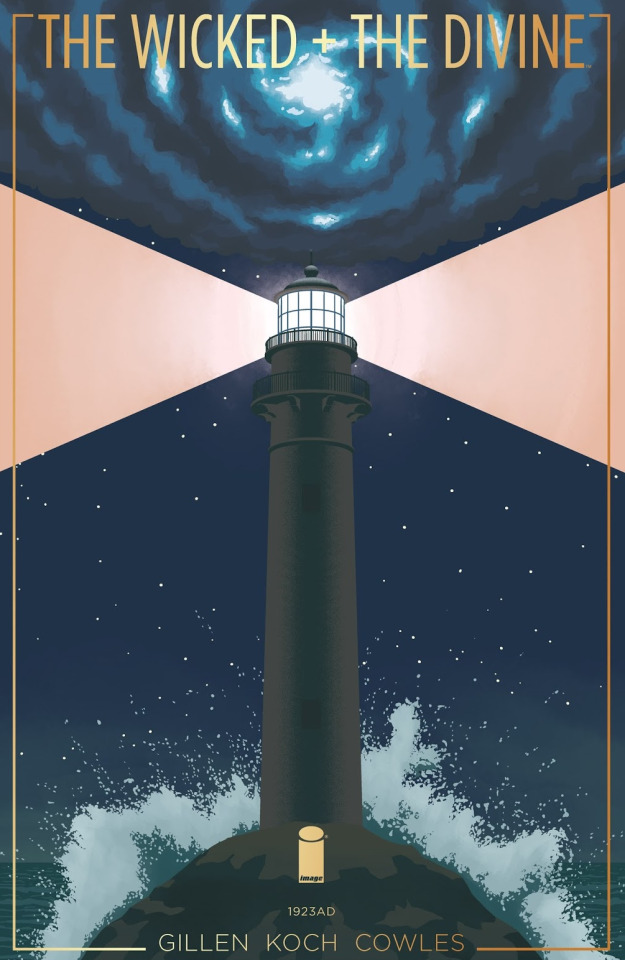
This issue is the Peakiest of Peak Gillen -- Gillen to the Power of Peak to the Power of Peak, if you will, #MathisCool. It’s a comic book masterpiece of research, reference and storytelling and I’ve been so daunted at attempting to comment on that it’s taken me months to make the attempt. You only climb Everest once, people! (Shut your mouth, Nat Geo.)
WAGNER VERSUS WARHOL, FIGHT!
In format the issue involves a back and forth conversation/rap battle between high and low art. On the one hand, we have novelistic chapters rich with description. “The island looked like a threat, a fist of rock that had forced its way through the waves.” The island and Ananke both...
Then we cut to what at first glance seems like your standard comic book, but in fact is actually a riff on the early days of film, complete with title cards (which themselves get so silly the font might as well be comic sans #IllBeHereAllWeek) and everything shot in a wash of black, white and brown, except for the splashes of red at the scenes of death—victims’ blood, Lucifer’s apple, and my favorite, the red seaweed around Neptune.

Love that red seaweed.
The heart of the plot follows a similar back and forth, as the elitist “classic” artists, the TS Eliot/Ezra Pounds and Ginny Woolf-ish-types of the Pantheon, want to kill the more popular art types, the Shirley Temples and Buster Keatons and Robert Johnstons, to initiate a nightmare scenario that will supposedly give them control over the zeitgeist of the future. It’s an incredibly disturbing take on some of the giants of the early 20th century -- and one Gillen found based in fact.
It’s fascinating, too, for as much as the real object of venom is the truly popular artists, the movie star types with their simplistic narratives and opium for the masses, the elitists focus on killing figures who from our perspective sit far closer to them – Lucifer (F. Scott Fitzgerald), Poseidon (Ernest Hemingway), Dionysius (Pablo Picasso) and the Morrigan (James Joyce). I wonder if it’s something about the chaos those specific figures represent, the way that their particular forms of art end up undermining not only the structures but internal belief system of the modern world. If Baal-Et-Al’s idea is to work with Joe Goebbels to coopt pop culture for their own We Will Keep Control project, in a sense a Picasso or Joyce was doing the reverse, presenting in the formats of the elites only to deconstruct their validity. (Gillen’s notes on the Morrigan point in this direction. Also, his description of Set as coming off “a little like Tahani from The Good Place made me laugh out loud.)
In the end our good guys will stop the bad using their own popular media, film from a train, which was in real life the very first motion picture, and terrified people back in the day for exactly the reason that they feared the train was real and was going to leap off the screen and kill them all.

Writing perfection.
HISTORY IN REPETITION AND RHYME
As we’ve seen throughout these specials, we get lots of echoes between periods here. Lucifer is once again the first one killed, the Morrigan is once again a character all about voice and drama (I love his self-narration so much, please sir can I have a spin-off?), the Norns are still trying to figure everything out, Susanoo=Dandy Baphomet, complete with his own complicated dating relationship (those rings made out of light, though, such a pristine beauty of a moment that Baph never gets), and Woden is once again a gross racist hack misogynist -- that submarine has got to be phallic, right? -- who has stolen his tech powers from someone else to produce content that is entirely derivative while secretly playing the gods and being used by Ananke.
There is also another mechanical creature, “Little Brother”, which we see only for a few panels, and that is not nearly enough because it is an adorable looking flying squid. (SCREW YOU BABY SHARK, BABY FLYING SQUID IS EVERYTHING.) Ananke also works from her standard playbook here, the Prometheus Gambit – you can gain some life if you kill others, which Baal et al will then use for bat#!% crazy purposes, which of course is also part of her plan.
And Minerva is also once again a child who seems maybe to be working with Ananke. It’s clear right from the start that the whole Shirley Temple schtick, lots of Yays and Gollys, is just an act, part of her “character”. And we get a glimpse of the real her again at the end.
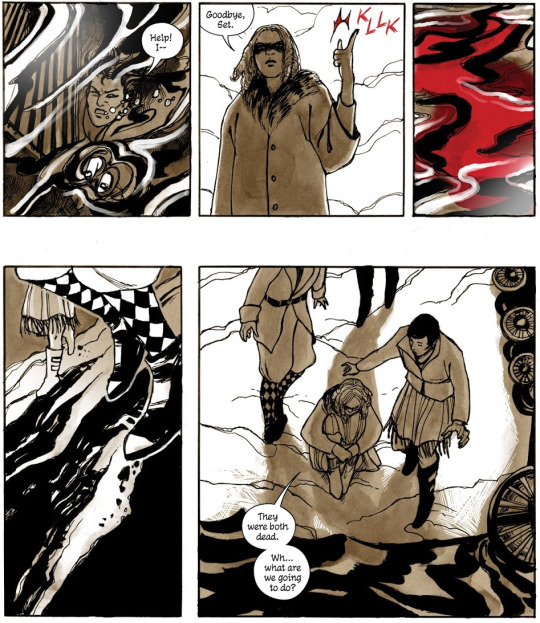
That doesn’t have to mean she’s in league with Ananke. (Just read the next arc; she’s totally in league with Ananke.) But she also comes to know what happened to Verdandi, when she wasn’t with the group that discovered him. (Dude: She’s totally in league with Ananke.) And it gives her an excuse to leave Morrigan at precisely the right moment for him to get murdered by Ananke. (Yes, exactly, because she’s in league with Ananke.) And she will kill Set herself without a second thought; it’s all still just hint and innuendo (UGH NO IT’S NOT STOP), but given what we’ve just learned in the present day that’s all we need for now.
Meanwhile Baal is in some ways the opposite of ours, a racist white elitist who dismisses James Baldwin-type Amon-Re as incapable of being an artist given his “nature”, and Set is her own thing too, a snobby name-dropping Virginia Woolf. Most intriguingly, the Norns have internal divisions that break them down, which make me worry a little bit for Cassandra and her friends.
Best take care of your family, Cassie. Remember, in #WicDiv no one is just a sidekick…
CREATURE(S) IN EBONY This is the second special where the Fall of the Gods involves the introduction of a new being created by the gods by way of a classic Ananke “Definitely Don’t Do This (wink wink)”. In 1831, Lucifer and Morrigan resurrect Hades to create an energy vampire that after killing them merged with Woden Shelley to create Steam Punk Elsa. This time the being – again a woman – is described as “looking like some ancient ancestor of the Metropolitans, but made of living poetry and bleak lightning rather than simple metal.” Which sounds an awful like the 1831 Creature.
She also emerged from “an ebony luminescence with streaks of blue beyond blue”, which again, sounds a lot like Mary Shelley Elsa Frankenstein.
Almost 92 years later we’ve heard nothing from her. But Kieron never forgets anything, INCLUDING YOUR BIRTHDAY, SO WATCH OUT. What could this all possibly mean…
ANANKIERON CHRISTIE
For me the most interesting element of 1923, though, is everything to do with Ananke. We come into the special, like the last two, knowing she is our Big Bad (probably, I don’t know you guys, I think in the next arc Kieron’s going to make me feel bad for her and I don’t want to). (No worries, he didn’t, or did he, wait, there are two Anankes now, I don’t know, what?)
But here for the first time we enter into the story alongside her. In fact, in that very first shot it almost seems like she’s looking right at us.
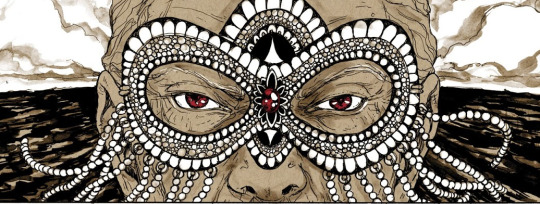
Time’s running out, she’s got to get to the murder-y and behead-yness stat, and this time we get to watch her do it. Awesome!
It’s almost like we’re partners in the exercise, even; right before they’re about to go in for dinner and discover Lucifer Ananke seems to stop and look at us again.

Us and the millennia-old serial killer of children--High fives all around!
For the last 30+ issues I’ve been asking why Ananke is she always wearing a mask, and now finally I get it: just like the Pantheon, she is an actor giving a performance.
Here specifically she presents herself as a classic Agatha Christie protagonist, finding herself along with everyone else in the Remote Place version of a locked room murder mystery and slowly working to uncover the truth of what’s going on while others continue to die. And Then There Was Fun!
Except in fact Ananke is not The Marple but Christie herself, author of the entire series of events that happen, which makes this to my mind pretty much the greatest Christie story ever, and also reinforces the belief of All of Us that Jessica Beatrice Fletcher is the Greatest Fictional Serial Killer that Ever Lived.
But wait, though. Doesn’t that make Ananke basically…a writer? Like um, this guy…?

But that’s crazy. We’ve spent the last five years with him. He’s fine.
I mean yes, both he and Ananke fashion fictional Big Bads (Note: this issue has absolutely no trace nor mention of a Great Darkness, despite the fact that this entire Pantheon has been around almost to their Use By) and also Ways to Save the World which motivate the characters down paths which lead to their eventual destructions.
And okay, true, in this issue Kieron does spotlight/ridicule parts of the storytelling mechanic, the machines characters are always trying to find/build/repair as nonsense.
Such rituals are actually simple. It is about will and art. The machines…in my experience, they are little more than props. All that matters is your action and intent. They killed so the world would die. You die so the world can live.
But still, if we were to accept that Ananke is Just Kieron’s, er, Mask, then it’s like this whole time he’s been the one doing terrible things to all these characters, including the characters that he made me want to love.


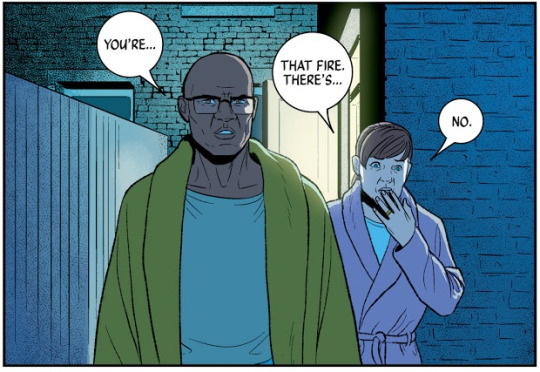
And then this question which I’ve been chewing on since 455 AD, whether the characters can ever be free of the roles they’ve been assigned, in a sense becomes a question about whether they can ever escape not Her but Him…
Or what about us? The Audience. The ones that Jamie and Kieron and the others are creating this for.
This isn’t And Then There Were None, is it? No, this is Temple of Doom. Kieron may be Mola Ram, but I’m the Ever-Hungry, Never-Satisfied G--D-- Kali.
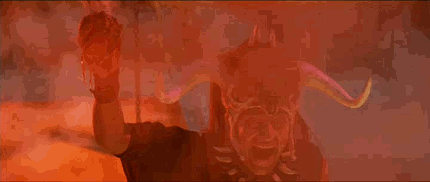
All along, Kieron has thrown in these moments where we get glimpses of the broader world, the way it feeds on the Pantheon. And I can get to the end of 1923 AD and say there’s a fascinating battle going on here about the ethics and/or violence of being a writer. But maybe there are also deeper questions being asked of me as a reader.
Maybe the issue begins with Ananke looking at me like that for a reason.

STOP IT, ANANKE. YOU’RE MAKING ME UNCOMFORTABLE. LOOK AWAY.
WORLD WARS, IRL AND URL A last point: 1923 AD is unusual for the degree to which it is haunted by something external, aka war. Even as the story takes place in the effervescent champagne bubble oasis of the Roaring 20s, both the nightmare that was World War I and the possibility of another war which is somehow impossibly much much worse than it hangs over the characters. That’s an insightful take on the period, but also an awe-full twist on the sense of doom that we’ve witnessed in the 21st century Pantheon, their own personal oncoming catastrophes expanded to the scale of disaster for the whole world.
It makes me wonder whether the last act of The Wicked + The Divine will involve something of a similar scale, whether the underlying momentum of the book has not always been toward the culture of celebrity, insofar as it engenders adoration, mob-think and a lack of fundamental care for and curiosity in one another, as sign of our own massive social crisis. (See: Brexit. Trump. The Fights My Dad Gets in on Facebook.)
Are we doomed? Do I still have time to tweet a thread about it? I really think it could make a difference, you guys.
3 notes
·
View notes
Text
I Never Can Say Goodbye
SPOILERS FOLLOW (AND ABOUND)
Tim: I’m aware there are all sorts of conspiracy theories pinballing around the blogosphere (boy, it’s been a while since anyone used that word, huh?) about Dionysus’ final fate, but assuming the icons in the title page are any kind of reliable narrator, it looks like we lost two members of the pantheon in issue #32. The storm that has been threatening to break throughout Imperial Phase has finally broken, and we’ve got the bodycount to prove it.

There’s an odd kind of symmetry to the departures in this issue, not least because they see my favourite and least favourite members of the Pantheon shuffled off this immortal coil.
Uncomplicated and kind-hearted jelly doughnut that I am, I was immediately drawn to Dio following his introduction; the nicest, most outwardly selfless member of the Pantheon with a profound connection to the dancefloor and a troubled relationship with sleep? How could I not love Dio?
As for Sakhmet, I’ve written before about how she’s a character I’ve really struggled to get on board with. I understand the reasons for her emotional distance, her apathy and her cold-heartedness, but that doesn’t stop me from instinctively bouncing off them when it comes to liking the character. Plus, even with the layers of trauma she’s living with, you can’t really say she’s not in control of her actions, which makes her a pretty unrepentant killer of many, many people, all the way up to her death.

Their opposing places in my heart and more-or-less simultaneous departures aren’t the only thing that connect their deaths. Up until the end of Rising Action, all of gods departed in the same way: a quick snap from Ananke and off comes their head in a ball of light, gory and somehow clean at the same time. If we discount Ananke, who stood apart from the Pantheon anyway, that was true all the way up to issue #31.
Now, with Sakhmet’s murder of Amaterasu and Woden’s ill-advised attempt at supervillainy, the gloves are off when it comes to god-on-god violence, and with the gods adopting “No quarter given, and none asked!” as their new motto, it’s given rise to some more varied and, in a way, poetic, deaths.
Dio, who never stopped moving, can’t quite close the distance he needs to. Dio, who lived for the crowd, is beaten and broken by a horde of strangers and a gang of heavies. Dio, who spread his essence out between anyone who asked, ends up trapped, braindead in his own body.

As for Sakhmet, after so long treating sex as a disposable pleasure, she is undone by the one relationship that actually seemed to matter to her. After so long as the ultimate threat among the Pantheon, she’s taken down by the member all the others have worked to protect. And after so long glorifying in her own capacity for flawless violence, she is killed in brutal, clumsy fashion.
In some ways, issue #32 serves as a little Greatest Hits package for both departing gods. Sakhmet once again reminds us of her ferocity and her agility, that while she doesn’t care about anything, we should be extremely wary of her. Meanwhile, Dio is there, dancing among the crowd, the 1-2-3-4 beat driving him, as he sacrifices everything so that normal people can be free.
Dionysus and Sakhmet, two very different characters, dying as they lived.
#WicDiv#The Wicked + The Divine#the wicked and the divine#Sakhmet#Dionysus#kieron gillen#Jamie Mckelvie
35 notes
·
View notes